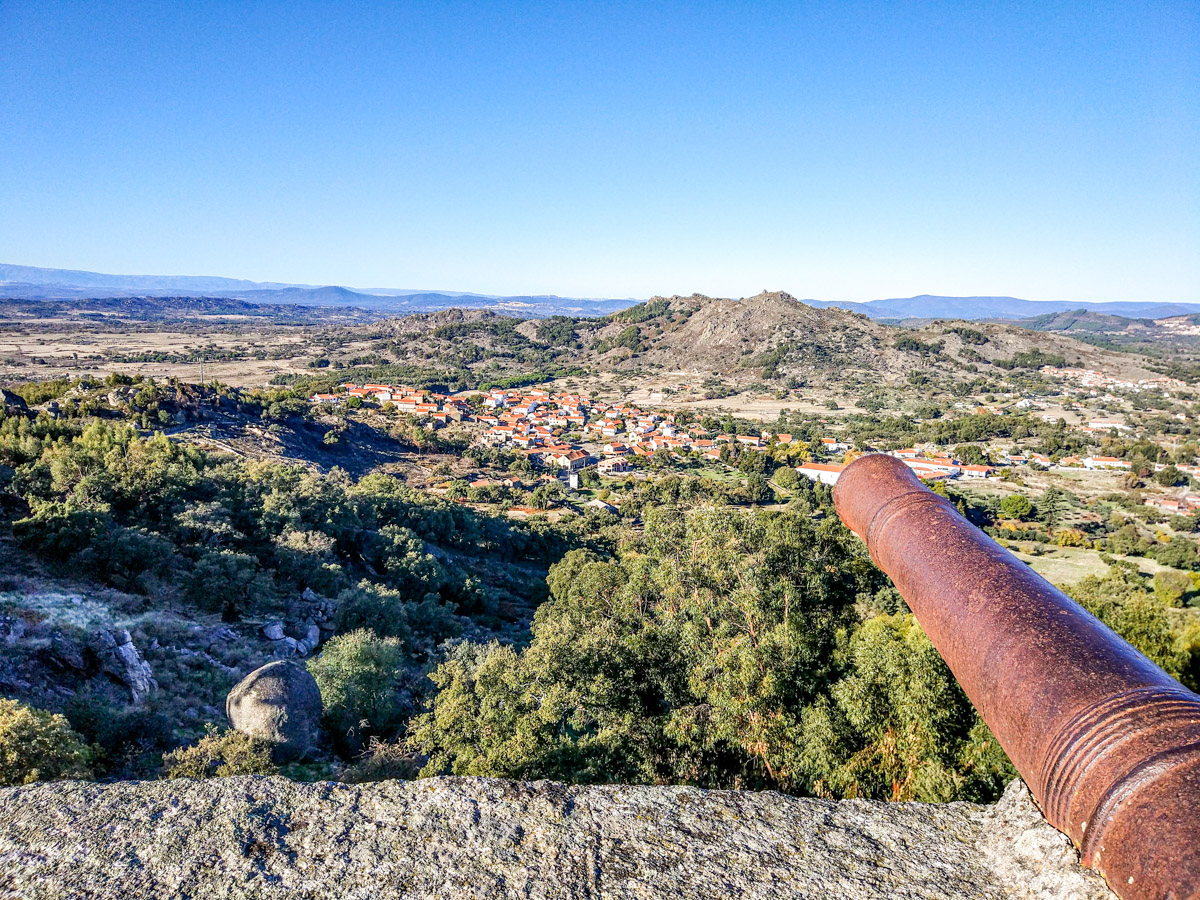Want to explore central Portugal off the beaten track? Portugal’s main historic villages, spread across the districts of Guarda, Castelo Branco and Coimbra, could be just what you’re looking for. I’ve visited them all and fallen in love with every detail. My favorites were Monsanto, Sortelha and Piódão.
The 12 Historical Villages of Portugal are one of the most interesting routes to take in the country, and there’s no shortage of incredible landscapes and nature, hand in hand with a brutal history. In this article, I’ll tell you what to do in each of them besides visiting their castles, as well as what not to miss in the surrounding area.
MORE ARTICLES FROM CENTRAL PORTUGAL: - Things to do in Espinho - Things to do in Ovar - Things to do in Aveiro - Aveiro to Costa Nova - Best beaches in Aveiro - Things to do in Mira beach - Things to do in Coimbra - Schist Villages in Portugal - Things to do in Figueira da Foz - Visit Monsanto in Portugal - Historical Village of Piódão - Things to do in Leiria - Visit Batalha Monastery and surroundings - Visit Alcobaça Monastery and surroundings - Things to do in Fátima - Visit Mira de Aire Caves - Things to do in Nazaré - Things to do in Peniche - Best beaches in Peniche - Visit Berlenga Island - Best beaches in Ericeira - Visit Ursa Beach - Best Beaches in Sintra - Best Beaches in Cascais - Best Costa da Caparica beaches - Best beaches in Setúbal - Best Beaches in Sesimbra - Visit Ribeiro do Cavalo Beach - Best beaches in Tróia, Comporta and Melides
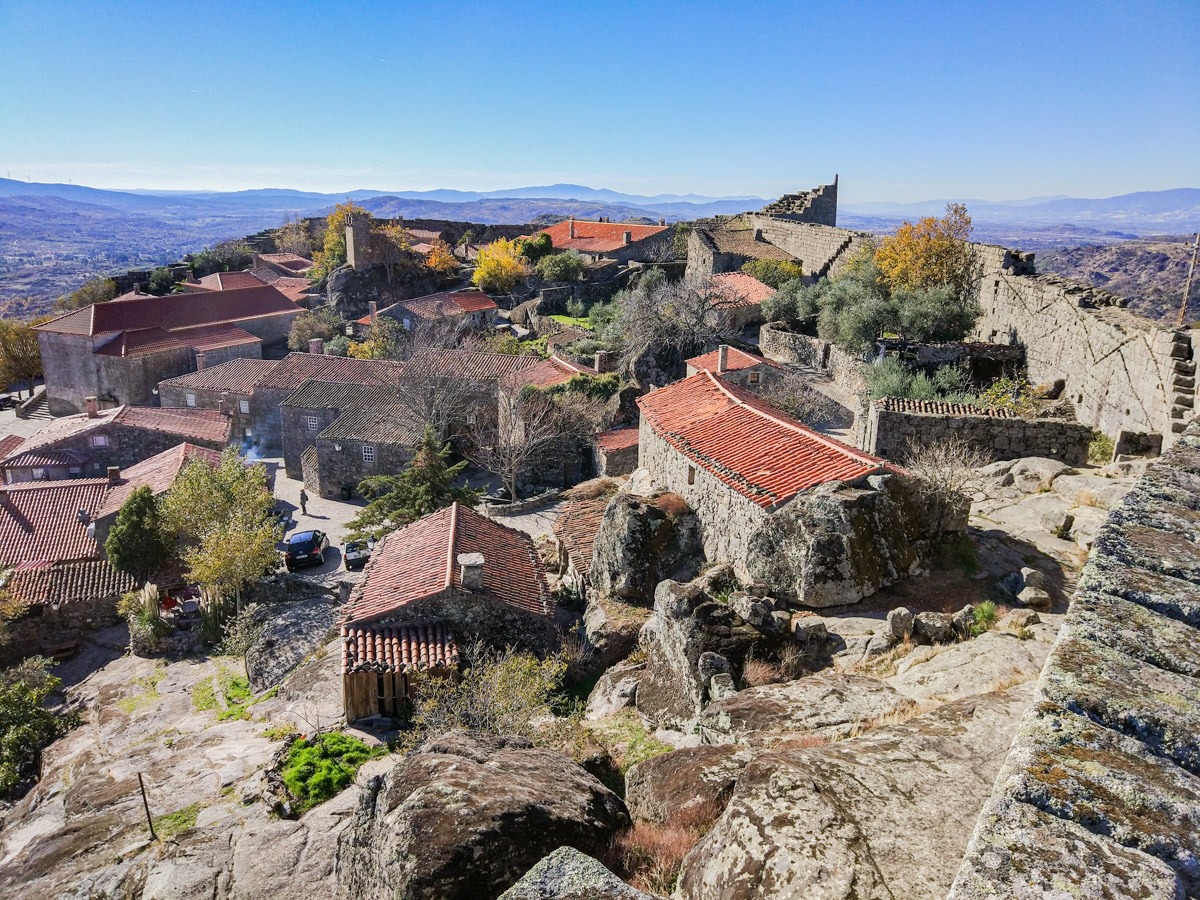
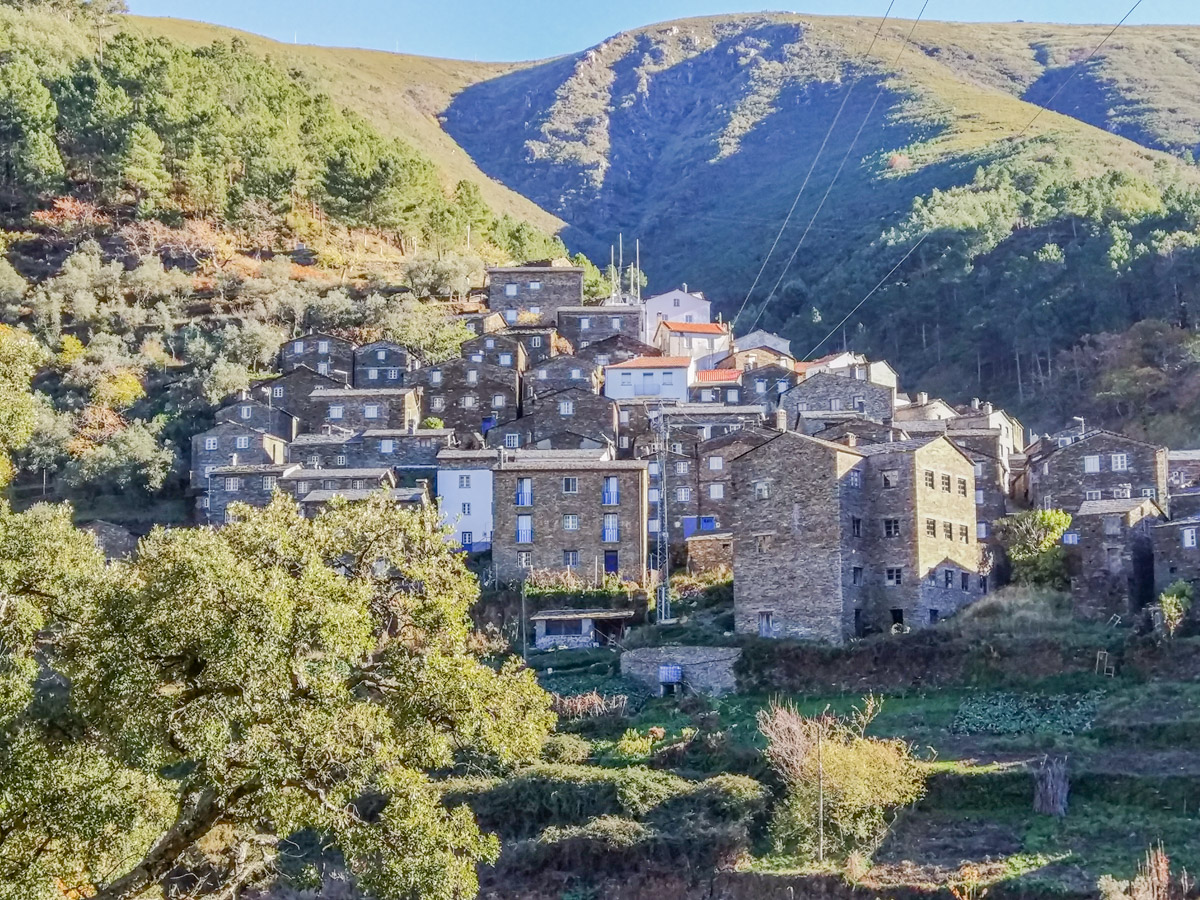
Which are Portugal’s 12 historic villages?
In this article I’m going to introduce you to more than 12 of Portugal’s historic villages, but there are 12 that are considered official. They are:
- The Historic Village of Sortelha, in the municipality of Sabugal.
- The historic villages of Castelo Mendo and Almeida, in the municipality of Almeida.
- The historic village of Castelo Rodrigo, in the municipality of Figueira de Castelo Rodrigo.
- The Historical Village of Marialva, in the municipality of Mêda.
- The Historical Village of Trancoso, in the municipality of the same name.
- Linhares da Beira, in the heart of Serra da Estrela, in the municipality of Celorico da Beira.
- The schist village of Piódão, in the municipality of Arganil.
- Castelo Novo, belonging to Fundão.
- The historic village of Belmonte, seat of the municipality of the same name.
- And finally, the historic villages of Idanha-a-Velha and Monsanto, both in Idanha-a-Nova.
While the first seven are in Guarda district, Piódão is in Coimbra, while the rest are in Castelo Branco.
Map of the 12 Historic Villages of Portugal
Portugal’s historic villages are located in Beira Interior, except for Piódão, which is in the district of Coimbra. I’ve left you a map with many of the points I’m going to mention below, which I think will help you plan your itinerary.
When to visit Portugal’s historic villages?
Portugal’s historic villages can be visited at any time of year. In winter you can complement your visit with an experience in the snows of Serra da Estrela, and in spring and fall with nature trails. Don’t forget the festivals of the 12 Historical Villages of Portugal, which take place on a date and month that can vary every year.
Also consider the cherry blossom season, or cherry picking season, which will give you a better experience in the historic villages further south, near Fundão. In the north, it can be excellent to visit Castelo Rodrigo, for example, during the almond blossom.
Accommodation tips for visiting Portugal’s Historic Villages
These are just a few tips, so you should always do your own research to find the best prices. I recommend the following places:
- Belmonte: Quinta da Ribeira | Casa Miriam | Pousada de Belmonte
- Sortelha: O Cantinho da Ana | Casas da Lagariça | Casa do Campanário
- Castelo Mendo: Casa de Sampaio
- Almeida: Casa do Forno | Casa do Ti Messias
- Castelo Rodrigo: Casa da Amendoeira | Casa da Cisterna
- Marialva: Casa do Leão | Hotel Rural de Longroiva
- Trancoso: Solar Sampaio e Melo
- Piódão: Casa da Padaria | Alva Valley Hotel | Hotel Rural Quinta da Geia
- Castelo Novo: Castelo Cottages | Cerca Design Houses
- Idanha-a-Velha / Idanha-a-Nova: Hotel Estrela da Idanha
- Monsanto: Casa Pires Mateus | Monsanto GeoHotel Escola | Hotel Fonte Santa (Monfortinho)
Gastronomy in Portugal’s Historic Villages
When it comes to the region’s cuisine, it’s best to opt for lamb or kid, or even hare or partridge. There’s also good bacalhau, for example à lagareiro, or excellent Migas de Peixe.
Desserts include rice pudding, curd cheese, the typical borrachões, corn porridge and tigelada. On the way to Castelo Rodrigo, don’t miss the fabulous almonds, and in the Fundão area you’ll find good cherries. Don’t forget to go to Celorico da Beira to taste the fabulous Serra da Estrela cheese, which is one of the 7 wonders of Portugal.
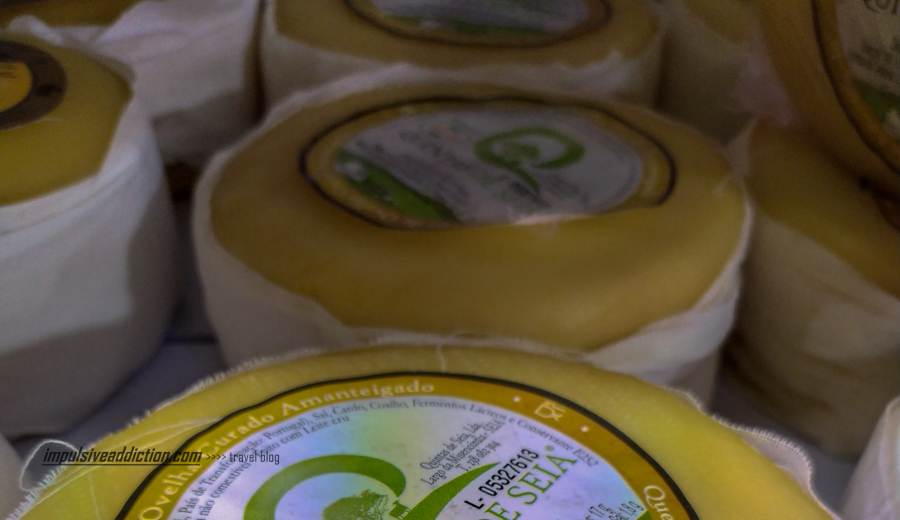
Restaurants in Portugal’s Historic Villages
- Belmonte – Restaurant Brasão
- Sortelha – Dom Sancho or Casa da Esquila
- Castelo Mendo – Quinta do Prado Verde, in Vilar Formoso.
- Almeida – Restaurant Granitus.
- Castelo Rodrigo – Restaurant A Cerca, Restaurant Arco-Íris, Taverna da Matilde or Saborearia.
- Marialva – Marquês da Marialva, O Mercado.
- Trancoso – Retiro do Castiço or Cantinho dos Arcos.
- Linhares da Beira – Cova da Loba, in Linhares; Albertino, in Folgosinho.
- Piódão – Solar dos Pachecos.
- Castelo Novo – Restaurant O Beiral, Restaurant O Mário, Restaurant Boguinhas, As Tílias, Restaurant O Lagarto
- Idanha-a-Velha – Restaurant Helena, Zé do Pipo, or Casa da Velha Fonte
- Monsanto – Adega Típica O Cruzeiro
Itinerary to visit the 12 Historic Villages of Portugal
This is the route I’m going to use to introduce you to Portugal’s 12 historic villages: the GR22 – Grande Rota das Aldeias Históricas. The GR22 has been designed so that you can also do it on foot, or if you prefer, by bike. I did it by car, so if you don’t have your own, follow this link to book one through Discover Cars.
- Belmonte >> Sortelha
- Sortelha >> Castelo Mendo
- Castelo Mendo >> Almeida
- Almeida >> Castelo Rodrigo
- Castelo Rodrigo >> Marialva
- Marialva >> Trancoso
- Trancoso >> Linhares da Beira
- Linhares da Beira >> Piódão
- Piódão >> Castelo Novo
- Castelo Novo >> Idanha-a-Velha
- Idanha-a-Velha >> Monsanto
The order above is the order I recommend for this itinerary. 5 days will be enough for you to do it all, but the more, the better!
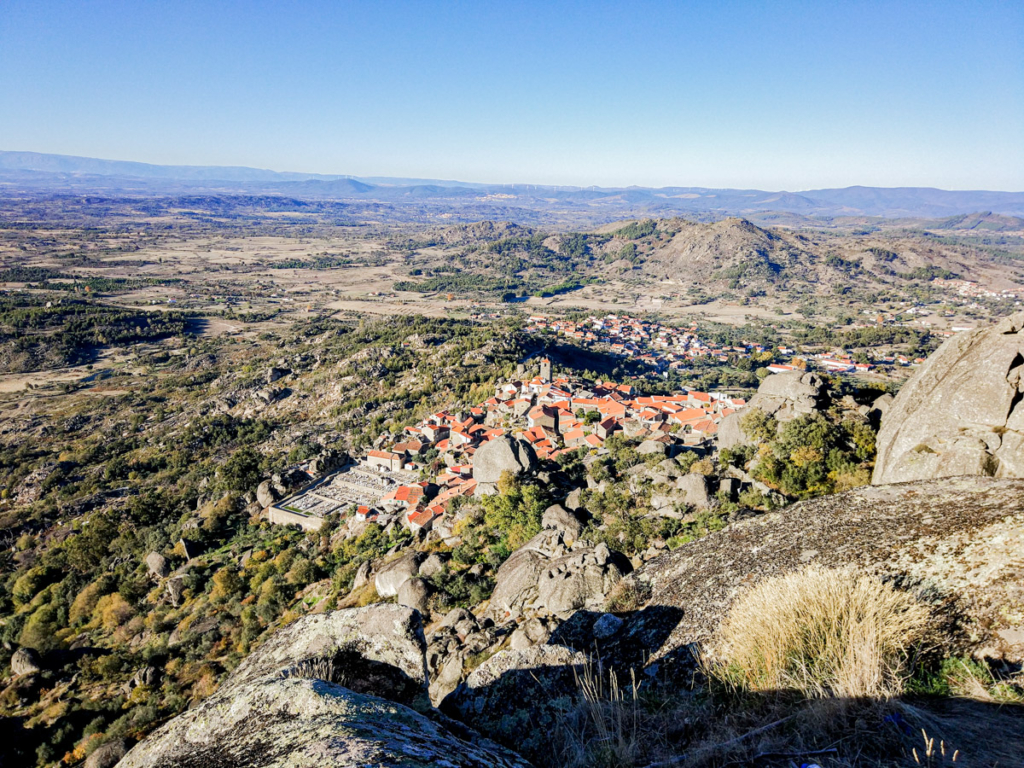
Belmonte | Historical Villages of Portugal
Belmonte is the birthplace of Pedro Álvares Cabral (who discovered Brazil), and also one of the most important Jewish communities in Portugal. It may not be the largest in the country, but it was the only Jewish community in Portugal to survive the Inquisition and the expulsion of Jews and Muslims from the Iberian Peninsula. To do so, they had to practice their religion in secret, which is why it is considered the most valuable and historically significant in Portugal.
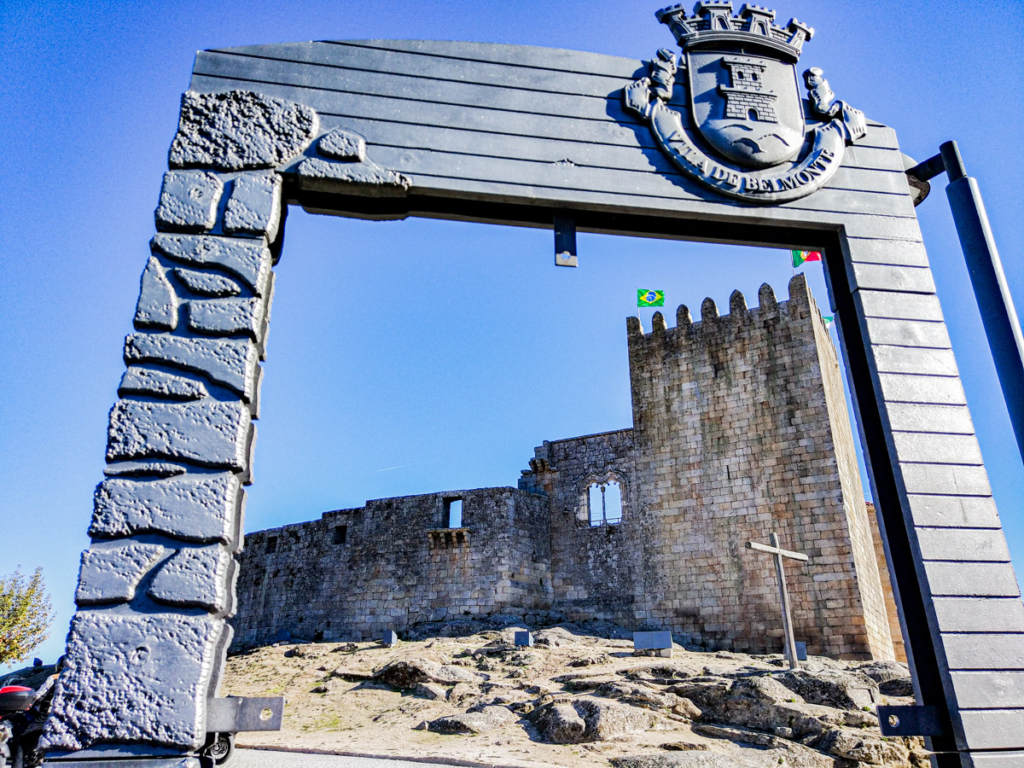
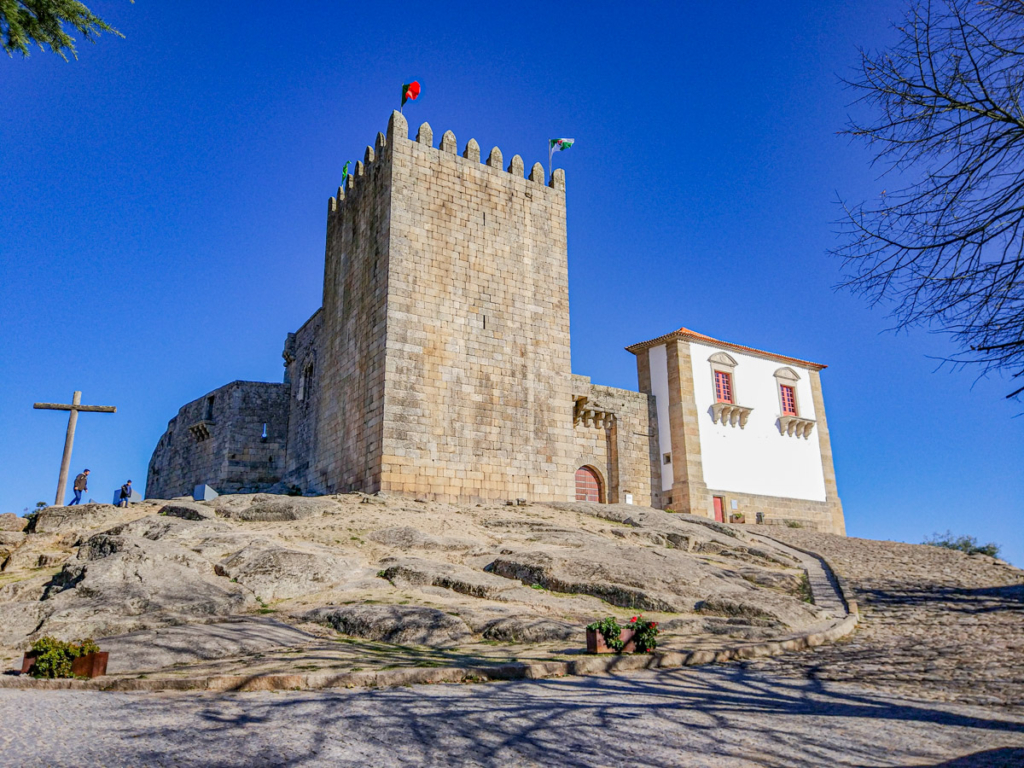
1. Must-see places to visit in Belmonte
- Belmonte Castle – Built in the 13th century during the reign of King Afonso III. In the 15th century, it was given by King Afonso V to the Cabral family, who lived there. Today it is a tourist building adapted into a museum with a beautiful keep.
- The Chapels of Calvário and Santo António (15th and 19th centuries respectively). Both are just a few meters from Belmonte Castle.
- The Church of Santiago de Belmonte and Cabrais Pantheon – The Church of Santiago is of Romanesque origin, from the 13th century, built by the Cabral family. The Pietá inside and the wall paintings stand out. Cabrais Pantheon, on the other hand, is attached to the Church of Santiago and dates back to the 15th century. The Renaissance tombs it contains date back to the 17th century.
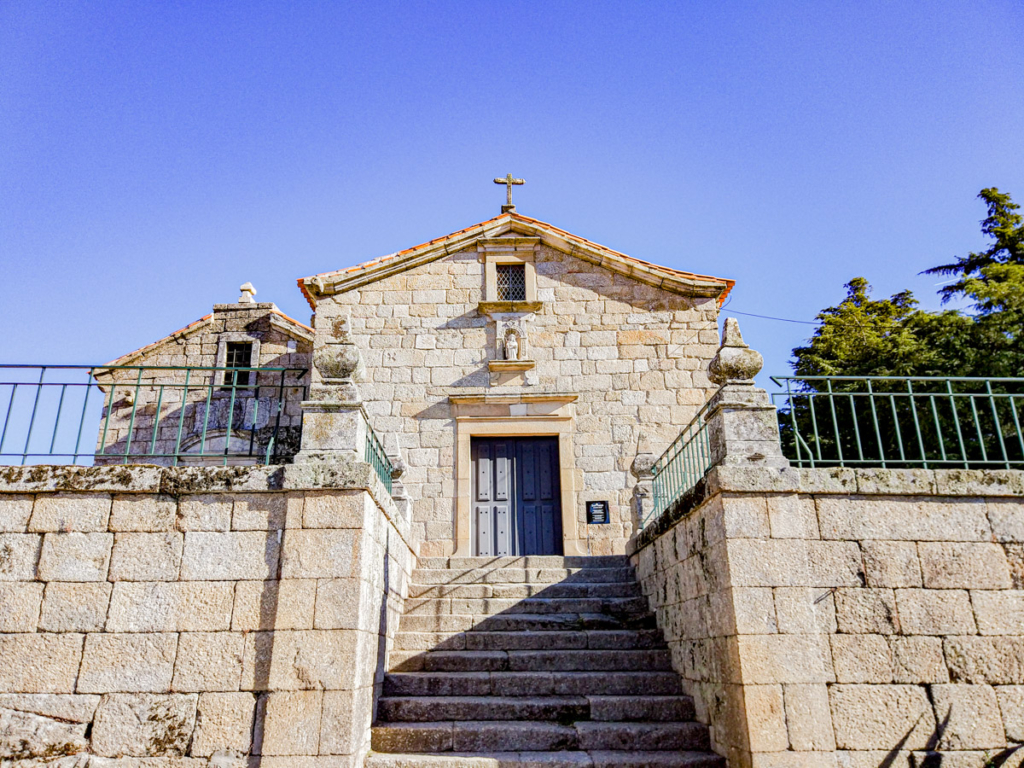
- Belmonte Synagogue and Jewish quarter. They bear witness to the existence of a Jewish community in this historic village since the 13th century (there are traces of a synagogue from that century). The number of Jews in the region increased dramatically with their expulsion from Spain, but with the start of the Inquisition in Portugal, many ended up leaving again, and those who remained kept the practice of their religion a secret. The current synagogue was inaugurated in 1996, named Bet Heliahu after the man who ordered its construction.
- The Statue of Pedro Álvares Cabral – will remind you that the Portuguese navigator was born in Belmonte between 1467 and 1468, the son of Fernão Cabral and Isabel de Gouveia, who belonged to the Portuguese nobility of the time. He was made a nobleman of the court when he was just 17, and then a Knight of the Order of Christ. He was commander of the maritime expedition that was responsible for the discovery of Brazil in 1500: he was only 33 years old.
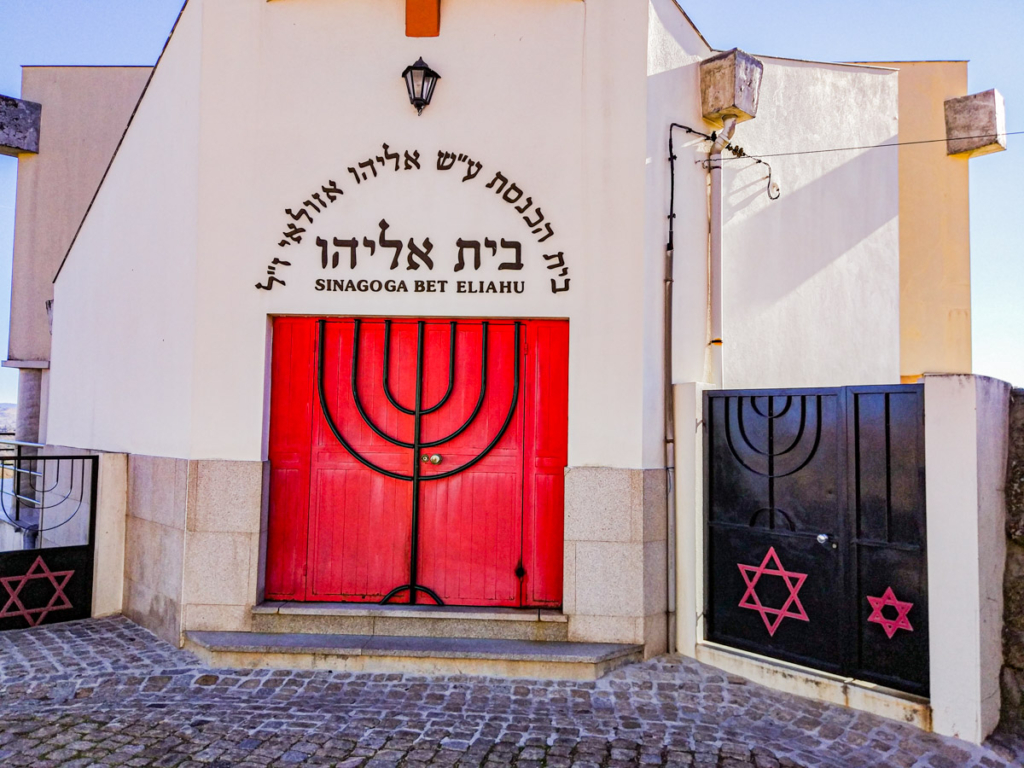
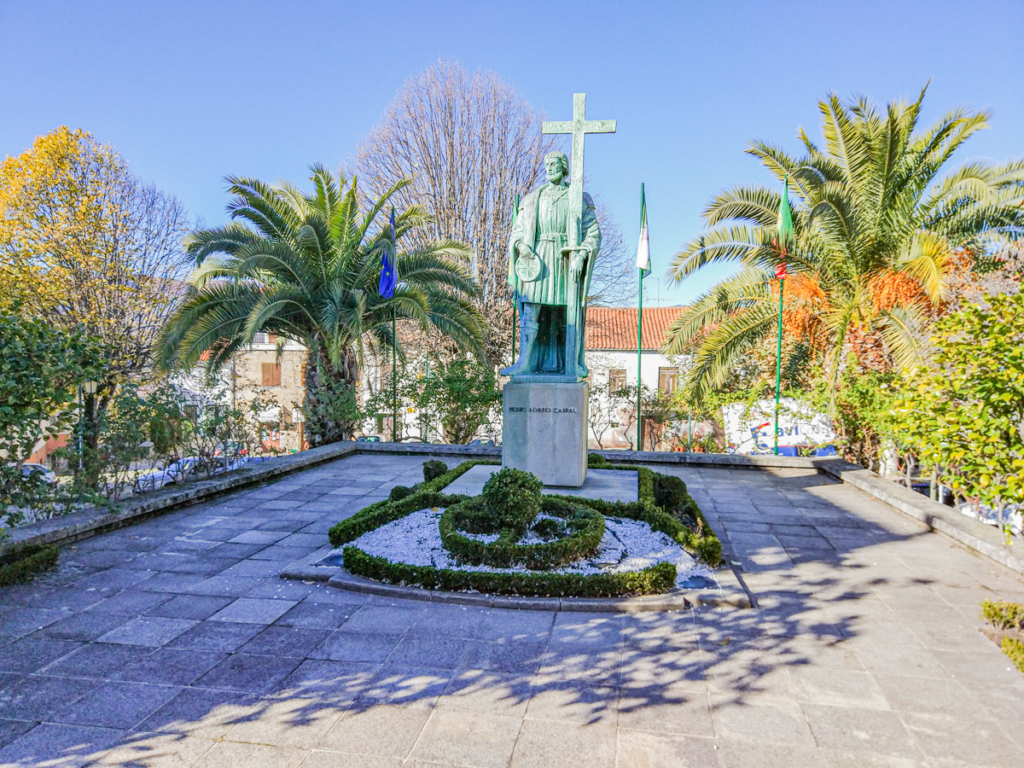
- House of Judaism in Belmonte – will show you some of the Jewish jewelry and porcelain, as well as some of the community’s products, including liqueurs, wines and even food products.
- The Hanukkah Candelabra, in front of the House of Judaism. Hanukkah is a Hebrew term that symbolizes the liberation and purification of the Temple of Jerusalem. According to the Old Testament, after the Temple was liberated, there was a lack of oil to keep the eternal flame burning, but it didn’t go out for 8 days, as a miracle, until there was oil again to keep it alive. The Candelabra has 9 arms, 8 of which are for celebrating the miracle, with a candle burning each day. The ninth arm, in the center, is called shamash, and corresponds to the candle that is used to light the others.
- The Republic Square and Belmonte’s Pillory. The Pillory dates back to the 16th century, but what you see today is a 20th century reconstruction, with some elements of the original still present.
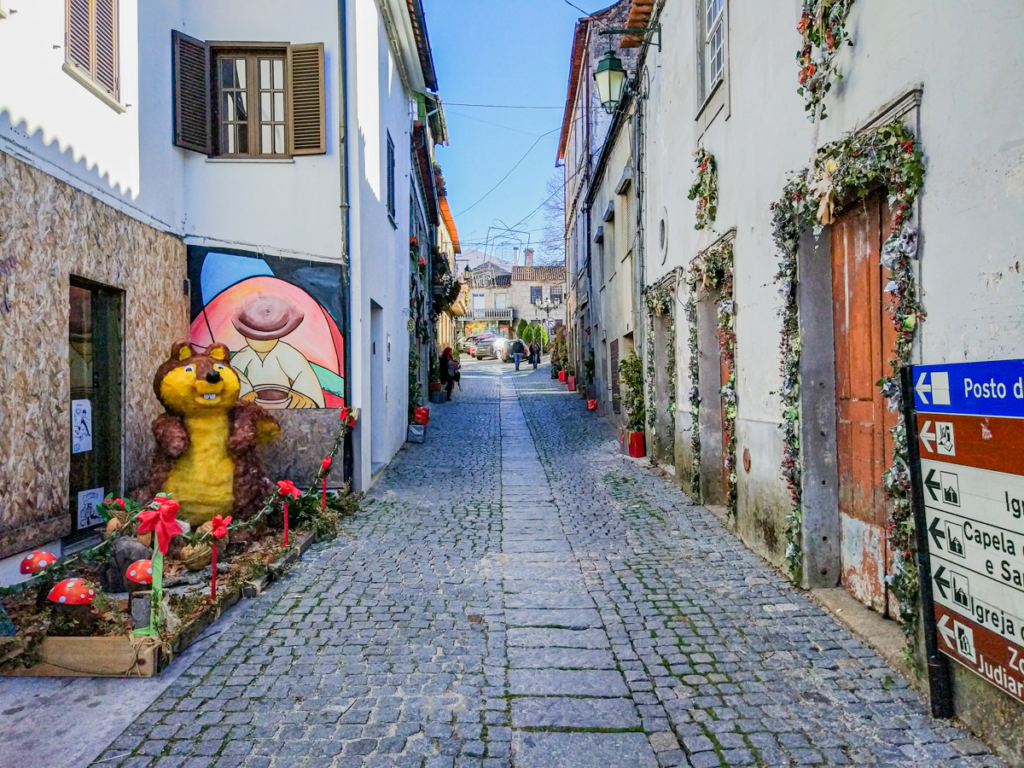
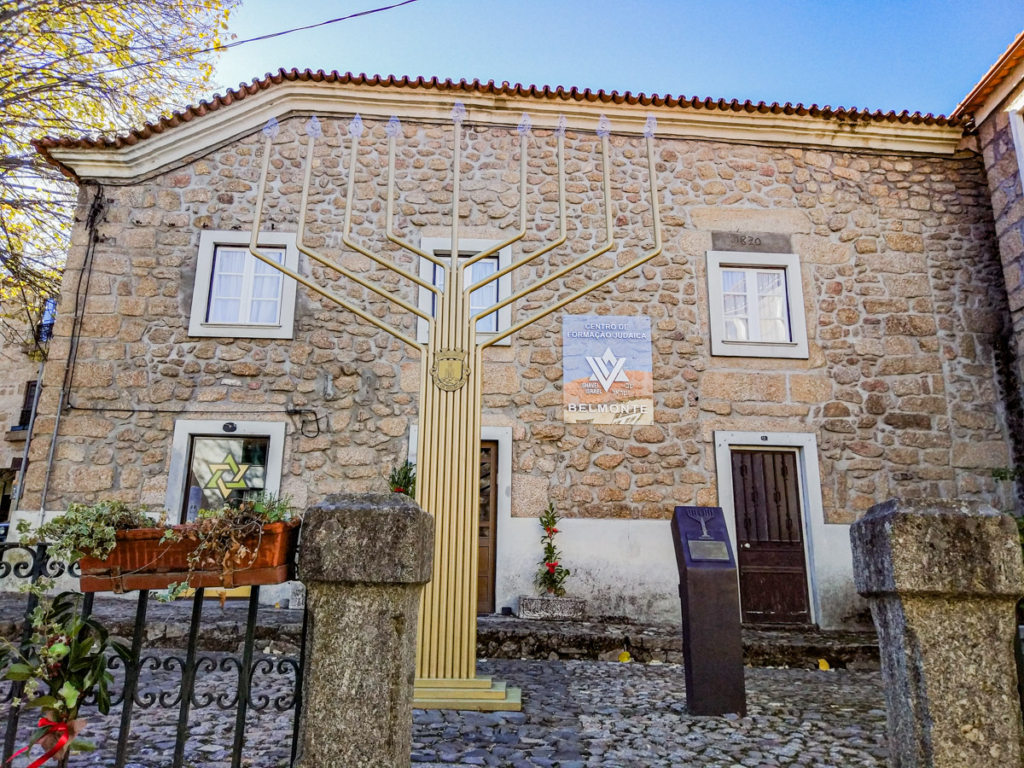
2. Other places to visit in Belmonte
- The Jewish Museum, where you can learn a little about the Jewish culture and history in the region. It has a collection of items dating from the Middle Ages to the 20th century, used by Jews and New Christians in their daily and religious lives.
- The Discoveries Museum, where you can learn more about the history of the discovery of Brazil.
- The Olive Oil Museum, which shows you olive oil production techniques and their importance to the village in the past and present.
- The Ecomuseum of River Zêzere, which tells the story of the river that originates in Serra da Estrela.
- Belmonte Mother Church, from 1940. The image of Nossa Senhora da Esperança stands out in the interior, which is said to have accompanied Pedro Álvares Cabral on the discovery of Brazil.
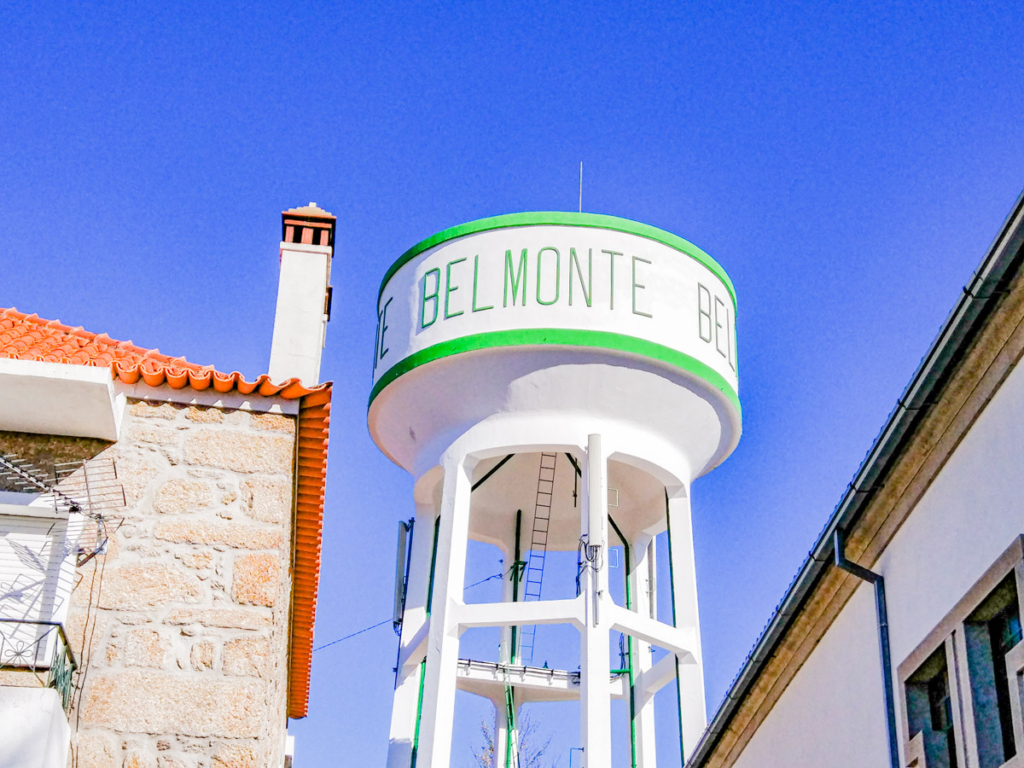
- The chapel of Santo Antão and the surrounding picnic area.
- The ruins of Centum Cellas, or Tower of St. Cornelius, located in Colmeal da Torre. They are believed to date back to the 1st century AD.
- The village of Caria: Tower House, Ethnographic House, Wheel House, Chapel of Santo António, Parish Church of Caria and its manor houses.
- The Tower House was built at the beginning of the 14th century as a residence for the bishops of Guarda, with traces of the old Caria Castle. It currently houses the Museum of the Territory.
- The Ethnographic House presents the Caria House of the past, and how people lived in this village, with replicas of the kitchen, living room and bedrooms of the past. There are also exhibitions related to the old professions, such as carpenters, barbers and shoemakers.
- The Wheel House dates back to 1784. This was where the rejected children and their belongings were left, and where they were raised until they were old enough to work. It was a kind of orphanage in the old days.
For entry to museums and other tourist buildings when visiting Belmonte, consult the price list and conditions on the Town Hall website.
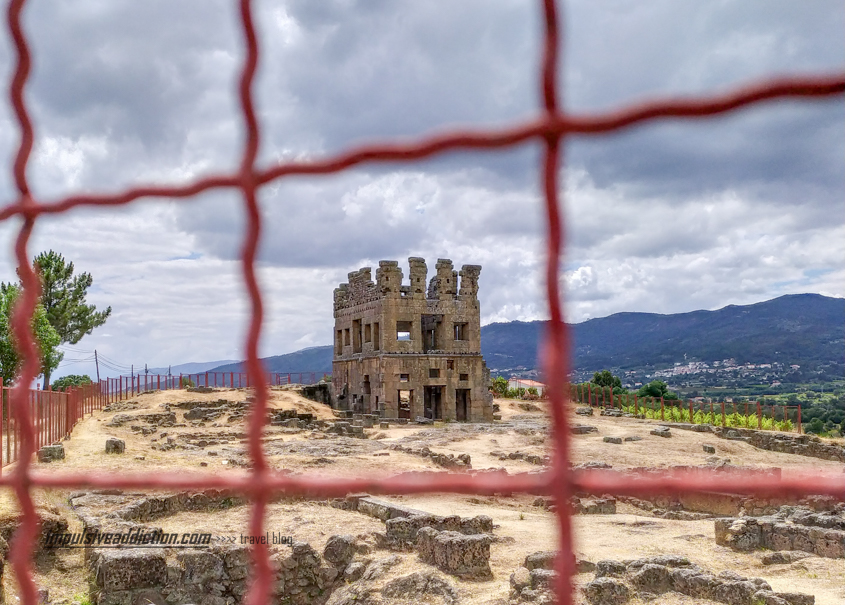
Sortelha | Historical Villages of Portugal
Sortelha is breathtaking. I’d venture to say that it’s my favorite historic village in Portugal, despite serious competition from the historic villages of Monsanto and Piódão.
The village of Sortelha is quite simply a pearl in the middle of the mountains. It seems isolated from everything and with fewer inhabitants inside the wall than you have fingers on one hand. I remember well its castle, its wall, the giant tree at the entrance that shelters visitors from the sun, the animal pens improvised by its few inhabitants, and the obvious surrounding landscape.
1. Must-see places to visit in Sortelha
- Sortelha Castle, walls and Facho Tower – Sortelha Castle was built in the 13th century, when it was granted a charter by King Sancho II, but the village already existed before the castle was built. Its quadrangular keep, the Facho Tower and the cistern stand out.
- The gates in the wall – there were four gates connecting to the outside: Porta da Vila, Porta Nova, Porta Falsa and Porta da Traição.
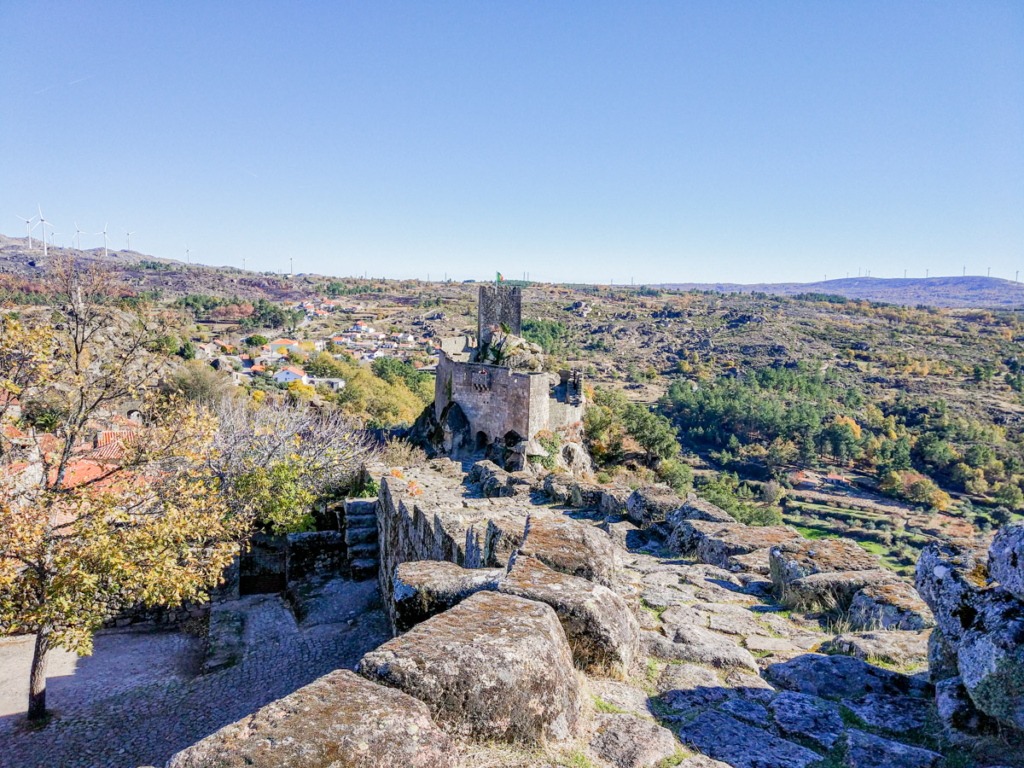
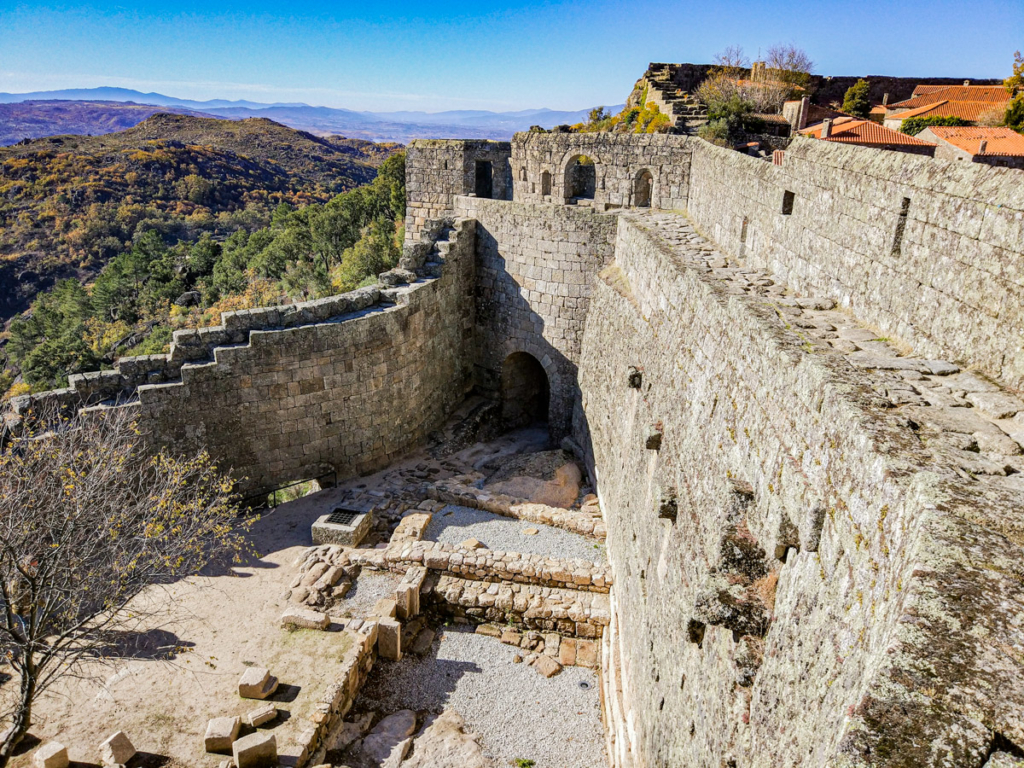
- The old Town Hall and Jail, dating back to the 16th century. The jail was on the lower floor and the town hall on the upper floor. The building was also an elementary school in the past, and today is the seat of Sortelha Parish Council, since the municipality of Sortelha was abolished.
- The traces of Manueline style in the houses.
- The Mother Church of Nossa Senhora das Neves, with Romanesque origins dating back to the 13th century. Of particular note is the image of Nossa Senhora das Neves with the child on her lap, which according to tradition was cut down by a Napoleonic soldier who wanted to see if it was made of gold. Don’t forget the Bell Tower on an adjacent cliff.
- Corro square, where you’ll find a huge centenary tree, classified as a Tree of Municipal Interest, which may already be around 600 years old and over 20 meters high.
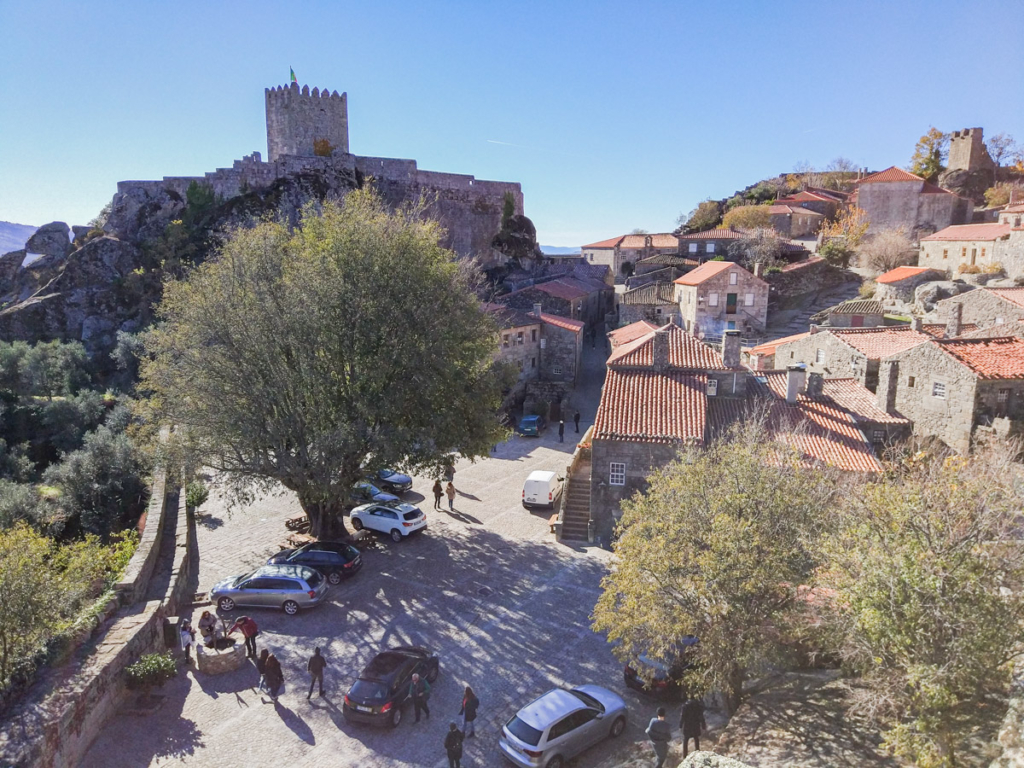
- House Number 1, next to the main square. It is said to have belonged to Ferreira Ferraz, former Mayor of Sortelha. The name of the house comes from the inscription on one of the doors.
- The 16th century House of the Falcons and the nearby fountain.
- The 17th century Governor’s House of Sortelha.
- The Arab House from the 15th or 16th century.
- The 16th-century parish residence on Rua Direita.
- The old Misericórdia Hospital, from the 16th century.
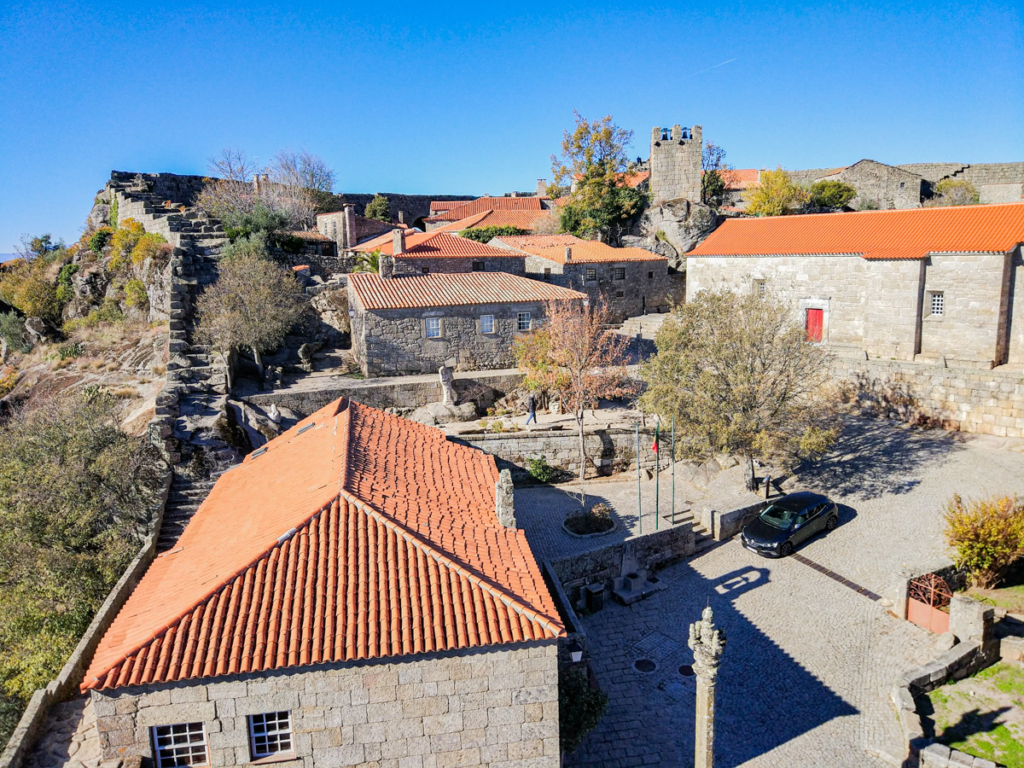
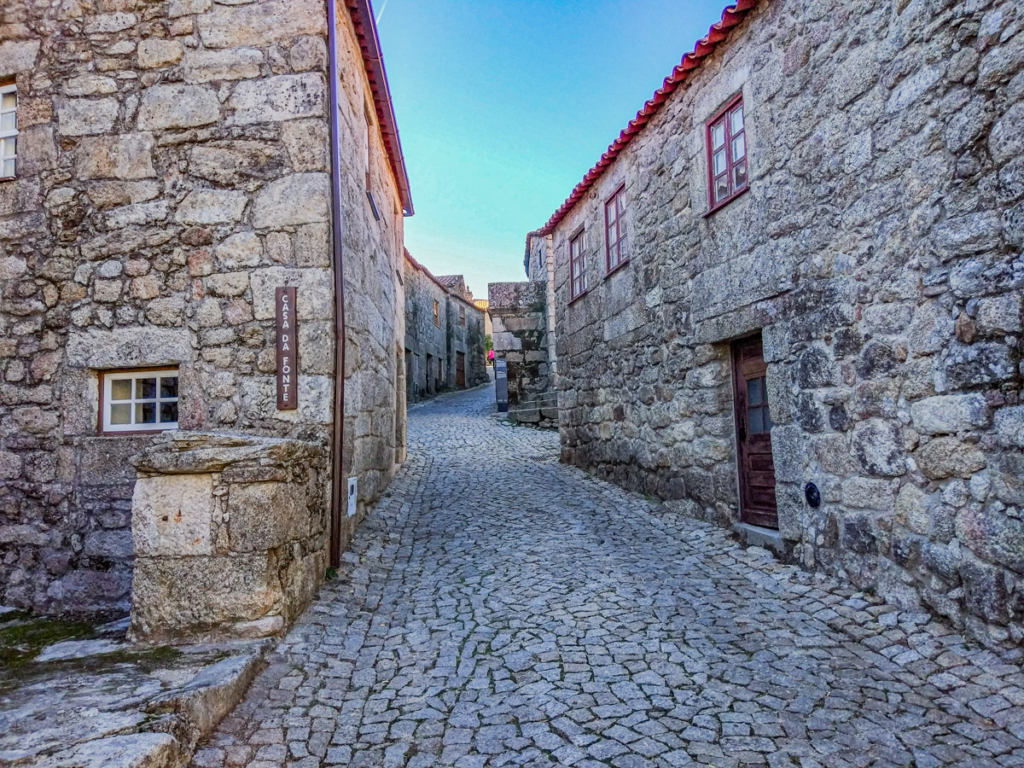
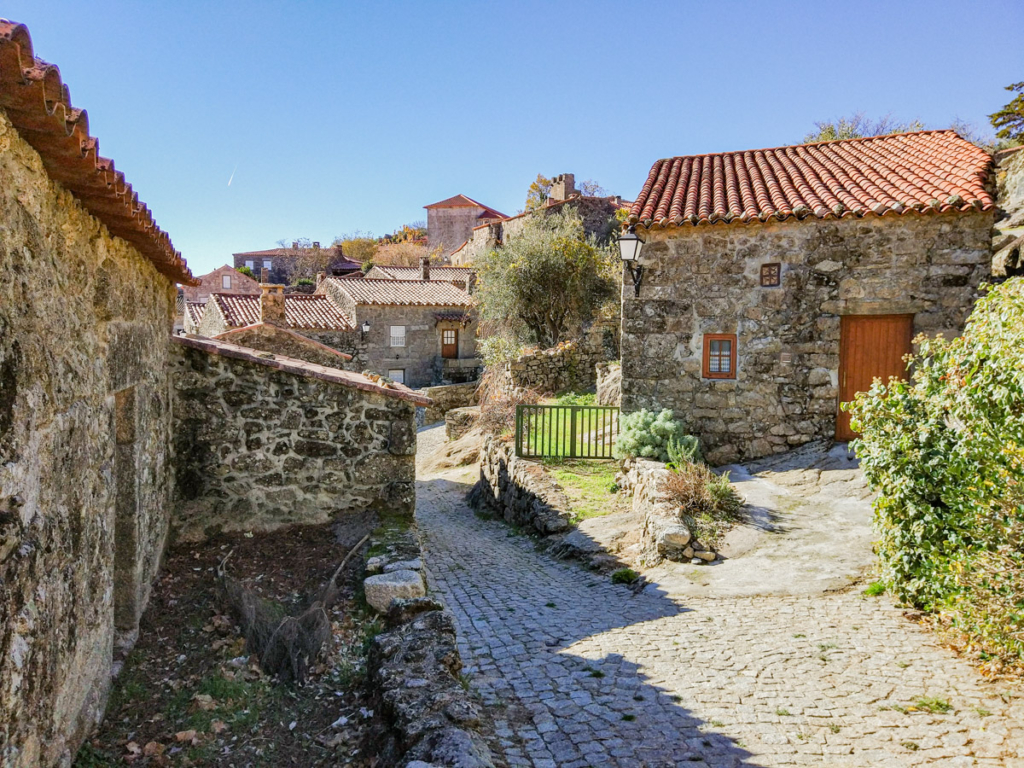
2. Other places to visit in Sortelha
- Cabeça da Velha Rock.
- The ruins of Misericórdia Church and the anthropomorphic graves. This church is also known as Church of Santa Rita or Church of São João.
- The rest of the medieval road by Porta Nova.
Castelo Mendo | Historical Villages of Portugal
I enjoyed a fantastic sunset from the top of Castelo Mendo castle. A great end to one of the days I spent visiting the 12 Historic Villages of Portugal.
Castelo Mendo, once known as Castro Mendi, is known to have been occupied since the Bronze Age, and traces of Roman occupation can be found there. Like other historic villages, it was very important in the defense of Portuguese territory after the Treaty of Alcanizes.
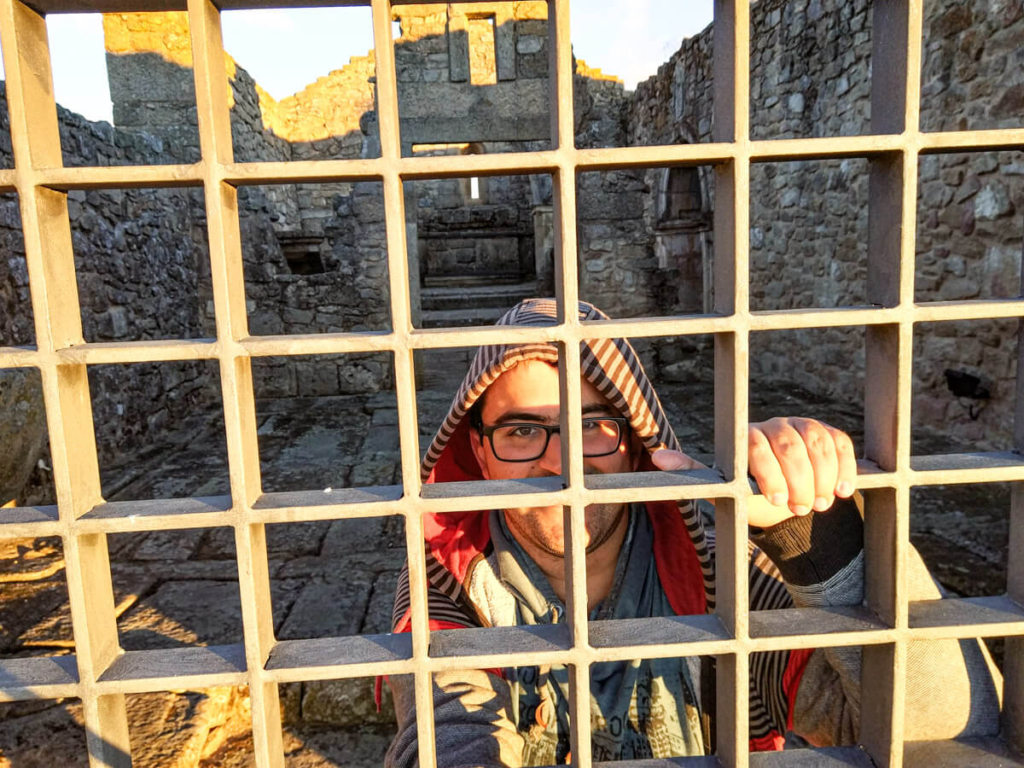
1. Must-see places to visit in Castelo Mendo
- Porta do Sol, Porta do Castelinho, Porta da Guarda and Porta de D. Sancho. These are the gates to the village and castle.
- The ruins of the Castle – originated in the 12th century.
- The Church of Nossa Senhora do Castelo – it dates from the 13th century (Romanesque) and was enlarged in the 14th century. The parish was abolished in 1834.
- The Nobleman’s Urn. Next to it you’ll find the inscription of Miguel Augusto de Sousa Mendonça Corte Real, nobleman of the Royal House and Commander of the Orders of São Bento de Avis and Nossa Senhora da Conceição.
- Pillory Square. As a curiosity, Castelo Mendo’s pillory is about 7 meters high, making it one of the tallest in Central Portugal. It dates back to the 16th century.
- The Mother Church of Castelo Mendo (Church of São Pedro) and the Church of São Vicente. The former was first documented in the 14th century. Its tower undoubtedly stands out. The Church of São Vicente, or Church of Misericórdia, dates back to the 13th century.
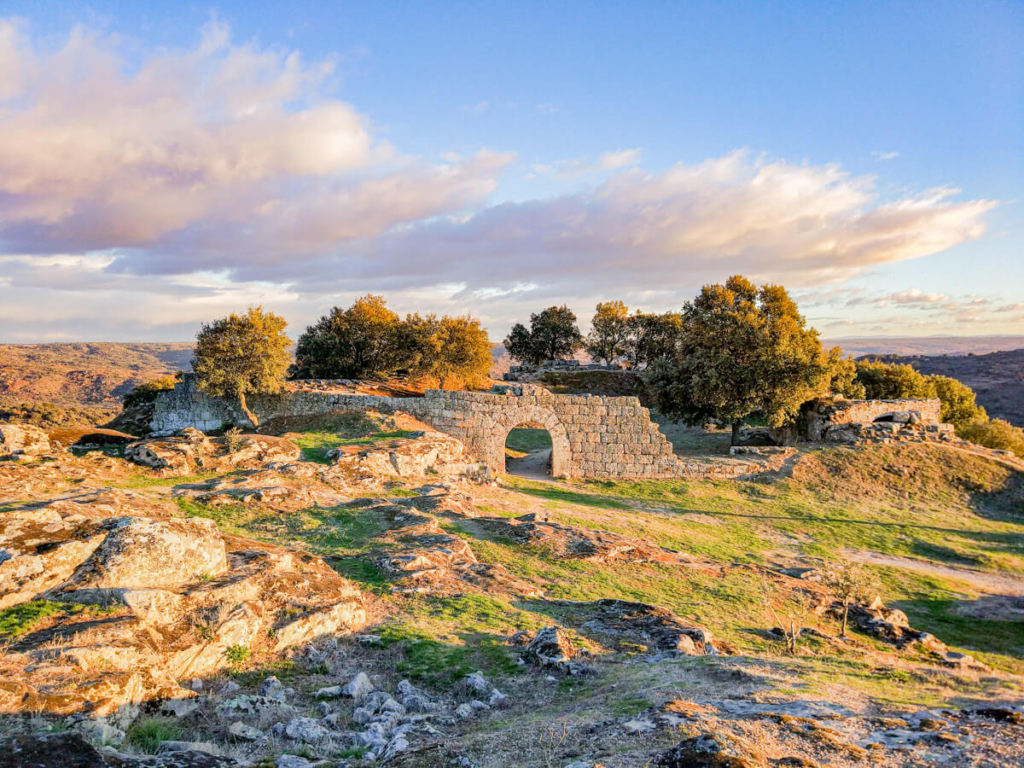
2. Other places to visit in Castelo Mendo
- Don’t forget the community oven.
- Admire the Manueline details on the houses in Rua do Forno.
- Walk the medieval road, which used to connect to the banks of river Côa, where ferries used to cross.
- Take a look at Mendo and Menda gargoyles embedded in the wall of the old Domus Municipalis. Some say they represent two forbidden lovers, like Romeo and Juliet.
- Visit the Museum of the Senses.
- Pass by the former Casa da Roda dos Expostos, where abandoned children used to be left.
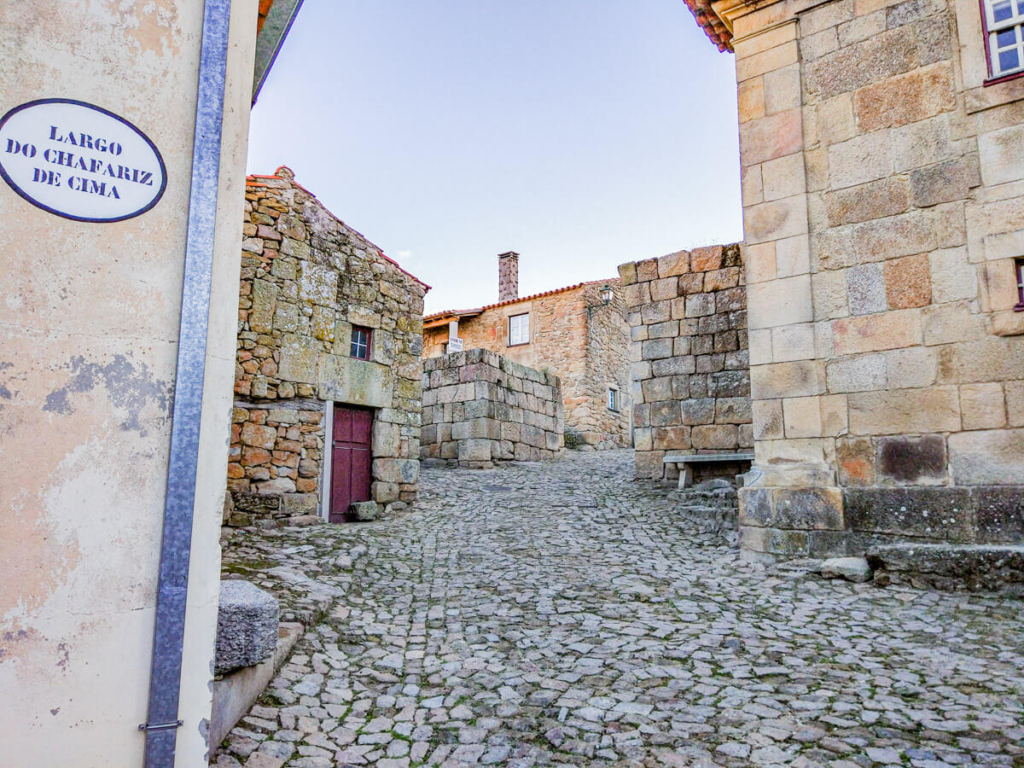
Almeida | Historical Villages of Portugal
Almeida is famous for its walls, in much the same way as Valença do Minho, in the north of Portugal, or Elvas, a bit south in Alentejo.
Apart from the Baroque military-style wall, which is clearly the main attraction in this Portuguese fortress, discovering Almeida also means visiting the military museum, the castle ruins, the clock tower, its squares, the riding arena, as well as the cemetery itself!
This historic village in Portugal was nicknamed Al-Mêda (the table) by the Arabs, which is probably where the name “Almeida” came from. It was reconquered by the Christians in 1190 and became part of Portuguese territory as a result of the Treaty of Alcanizes in 1297. Although during the Seven Years’ War in the 18th century it reverted to Spanish possession, it returned to Portuguese rule later in the same century.
In 1927, the last Cavalry Squadron left Almeida, which marked the end of military activity there. For me, this isn’t the most fantastic Portuguese fortress (I leave that to Forte da Graça, in Elvas), but it breathes history all the same. It’s definitely worth a visit!
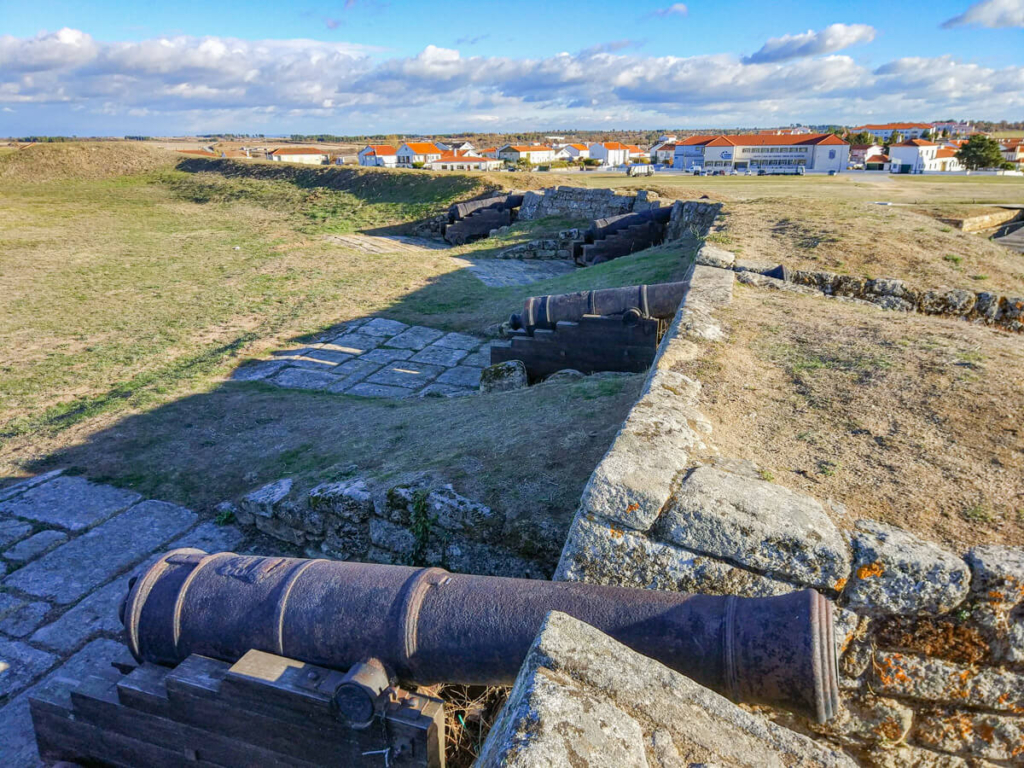
1. Must-see places to visit in Almeida
Being a fortress, there are plenty of military sights to see in Almeida. This is perhaps one of the villages with the most places not to be missed:
- The Double Doors of Santo António. Its proximity to CEAMA – Almeida’s Center for the Study of Military Architecture – is noteworthy. The Inner or Magisterial Door dates from the 17th century.
- The Double Doors of São Francisco da Cruz. The inner door dates from the 17th century, but the outer door is from the 19th century.
- The ruins of Almeida Castle and walls. They are a national monument and are believed to be of Arab or Leonese origin. The Castle was rebuilt by King Dinis in the 12th century, later during the reign of King Manuel I and also in the 18th century, this time as an ammunition and gunpowder store. The Castle has been in ruins since 1810, when it was blown up during the French invasions.
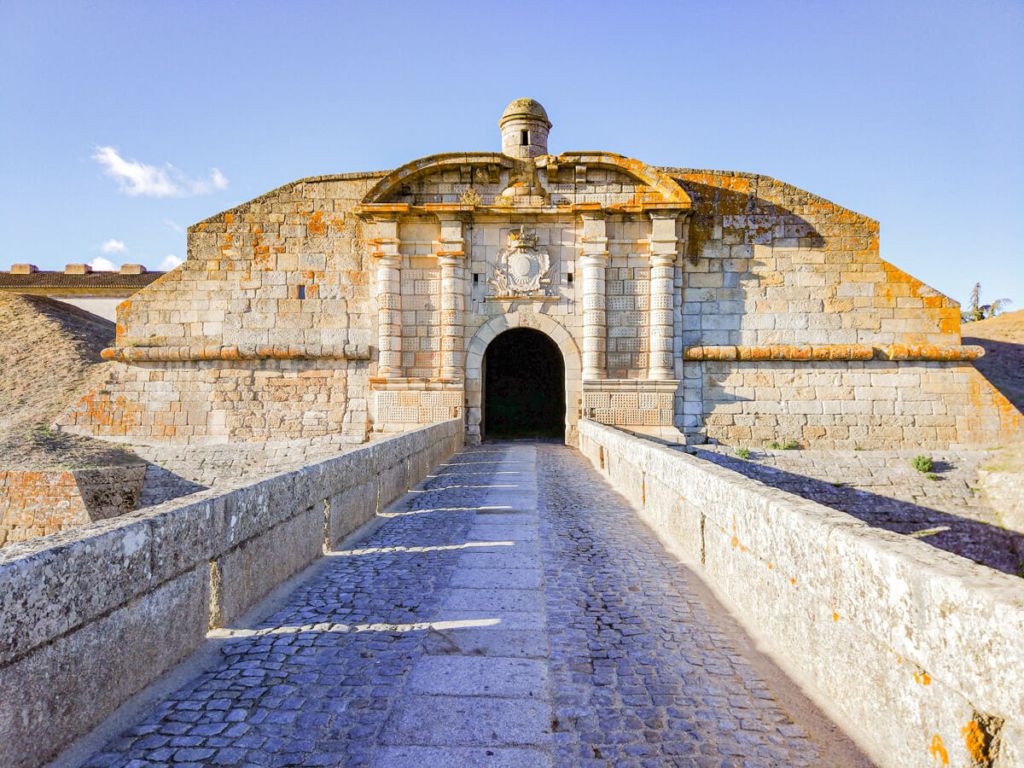
- The Almeida Historical and Military Museum. It is located in the underground galleries of the Bastion of São João de Deus, in the former Old Infantry Barracks (18th century), and has several rooms that give us a glimpse of Almeida’s wartime history.
- The Old Cavalry Barracks, or Santa Bárbara Barracks.
- The Almeida Center for the Study of Military Architecture (CEAMA)
- The Main Guard Corps, from the late 18th century.
- The Armory and Guard House, built in the 19th century.
- The Police Headquarters and Largo 25 de Abril
- The Blood Hospital / Revelim Doble
- Almeida’s Old Cemetery
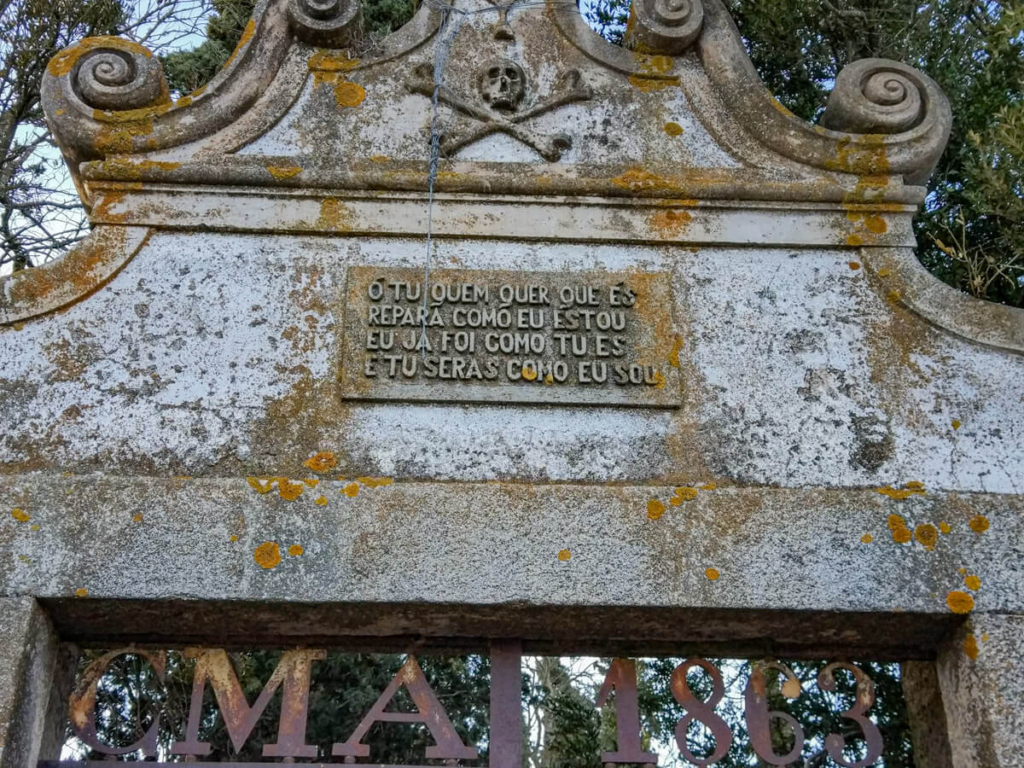
- The Clock Tower – located in the area around the castle, it probably derives from a former tower of the Mother Church of Nossa Senhora das Candeias, which no longer exists.
- Roda dos Expostos Museum. These houses were built in the 19th century to take in abandoned children. You’ll find similar places in other historic villages in the region.
- The Misericórdia Church and the Almeida Mother Church. The first dates from the end of the 17th century and has a portico reminiscent of the fortress’s Gate of Santo António. The second dates back to the 16th century and was initially part of a Convent of Nuns dedicated to Nossa Senhora do Loreto, and then a military barracks and hospital. It was only after the aforementioned explosion of the castle that it became the mother church.
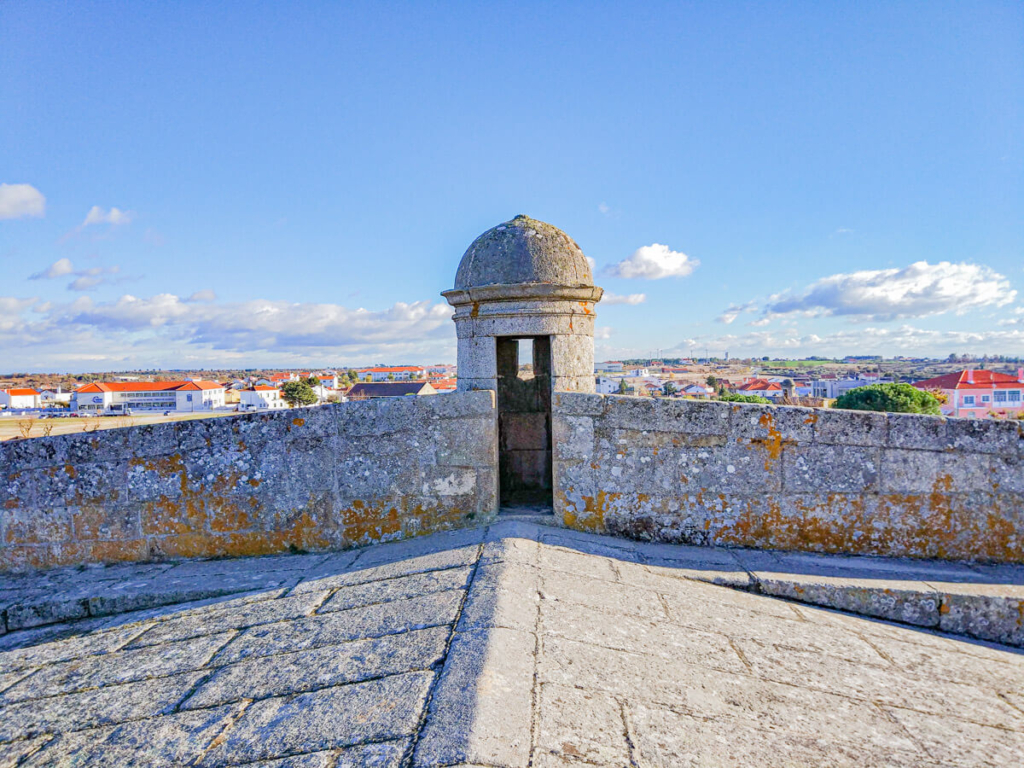
- The High Square of Almeida, located on the Bastion of Santa Bárbara. It marks the highest location in the entire fortress.
- The Noble Houses in the historic village, such as:
- The Brigadeiro Vicente Delgado Freire House, dating from the 18th century and located in Dr. José Casemiro Matias square.
- The António Pereira Fontão Júnior House, or Casa Grande, the home of a wealthy former merchant from the village.
- The Town Hall, dating from the 16th century, from which the Manueline coat of arms stands out.
- The 17th century Palácio dos Leitões, located on Rua dos Combatentes Mortos pela Pátria.
- The House of the Royal Auditors.
- João Dantas da Cunha House.
- The Manor House of São João da Praça, built in 1726 by Infantry Colonel José Delgado Freire. This is probably the most interesting of all the above.
- The House of Governors (Vedoria Geral da Beira).
- The Old Yard.
- And the Monument in Honor of the Combatants of the Great War.
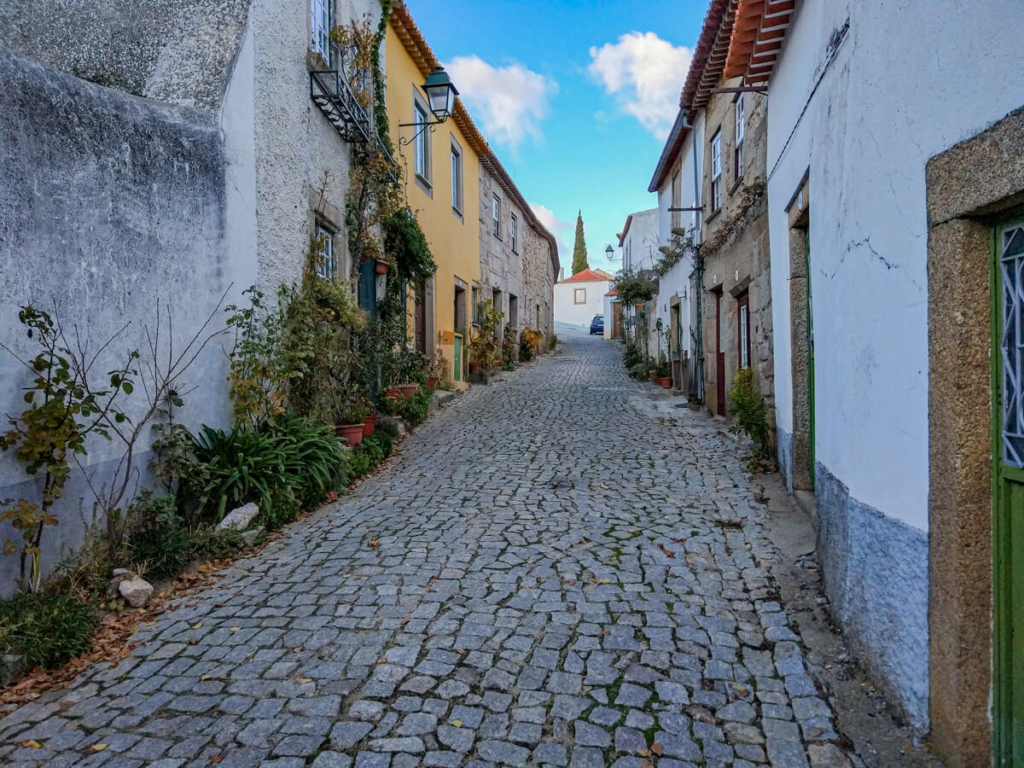
2. The outskirts of Almeida – Pinhel, Vilar Formoso and Castelo Bom
You can also head to Pinhel to visit the following places, at the very least. Pinhel is another historic village which, although it’s not part of the 12, you can include in your itinerary.
- Visit Pinhel Castle, with its Manueline architecture.
- Stroll around the Pillory square.
- Visit the Municipal Museum.
- Visit Convento dos Frades or the Convent of Santo António.
- Visit the Clock Tower.
- Visit the main churches in Pinhel: Church of Santa Maria do Castelo, Church of S. Luís, Church of Misericórdia, Chapel of Santa Rita, Church of Senhor da Coluna.
Don’t forget Vilar Formoso and Castelo Bom. The latter to discover its ruined castle, an incredible viewpoint, the Chapel of São Martinho and the Church of Nossa Senhora da Assunção.
Castelo Rodrigo | Historical Villages of Portugal
Castelo Rodrigo is one of Portugal’s wonder villages. It is also at the southern entrance to the Douro International Natural Park and can be an excellent starting point for an itinerary there, or even a hop over to Spain just next door.
As a curiosity, Castelo Rodrigo was conquered from the Moors in the 11th century and became part of Portuguese territory in 1297 through the Treaty of Alcanizes, signed by King Dinis.
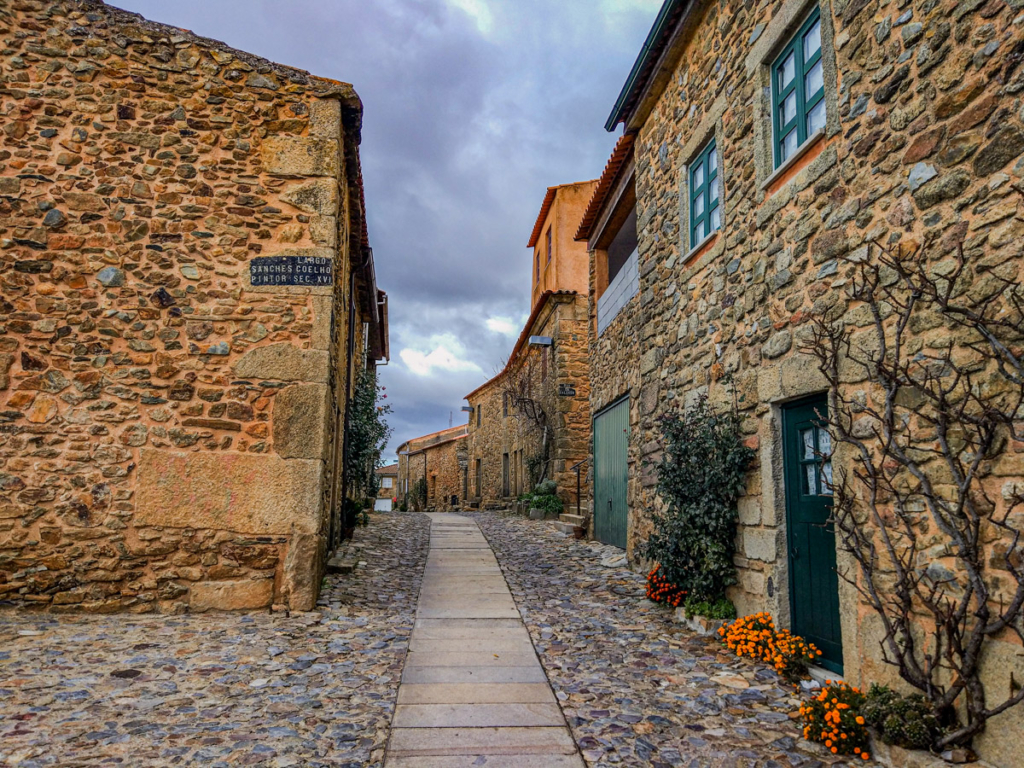
1. Must-see places to visit in Castelo Rodrigo
Along the path that separates the Castelo Rodrigo Leisure Park from the entrance to the village, you should stop to appreciate the collection of tiles depicting the region’s main points of interest:
- The Convent of Santa Maria de Aguiar.
- Castelo Rodrigo Pillory, considered a national monument, which originated during the reign of King Manuel I.
- The Cistern Well
- The Church of Nossa Senhora do Reclamador, founded in the 13th century by the Confraternity of the Friars of Nossa Senhora de Reclamador, hence its name: they were dedicated to assisting pilgrims from Santiago de Compostela. You should visit this church inside for the beautiful coffered ceiling paintings.
- The Palace of Cristóvão de Moura, residence of the town’s mayor, later Count and Marquis of Castelo Rodrigo during the Philippine dynasty.
- And the Walls of the village, built at the request of Dom Dinis after the Treaty of Alcanizes. These were walls with several semicircular turrets (Cubelos) to protect the border, which were later altered during the reign of King Fernando and rebuilt in the 16th century. Don’t forget its three ancient gates: Porta Nascente (an arch still remains and faces the border with Spain); Porta da Traição, or False Gate, with a secret connection to the Convent of Santa Maria de Aguiar; and Porta do Largo de São João.
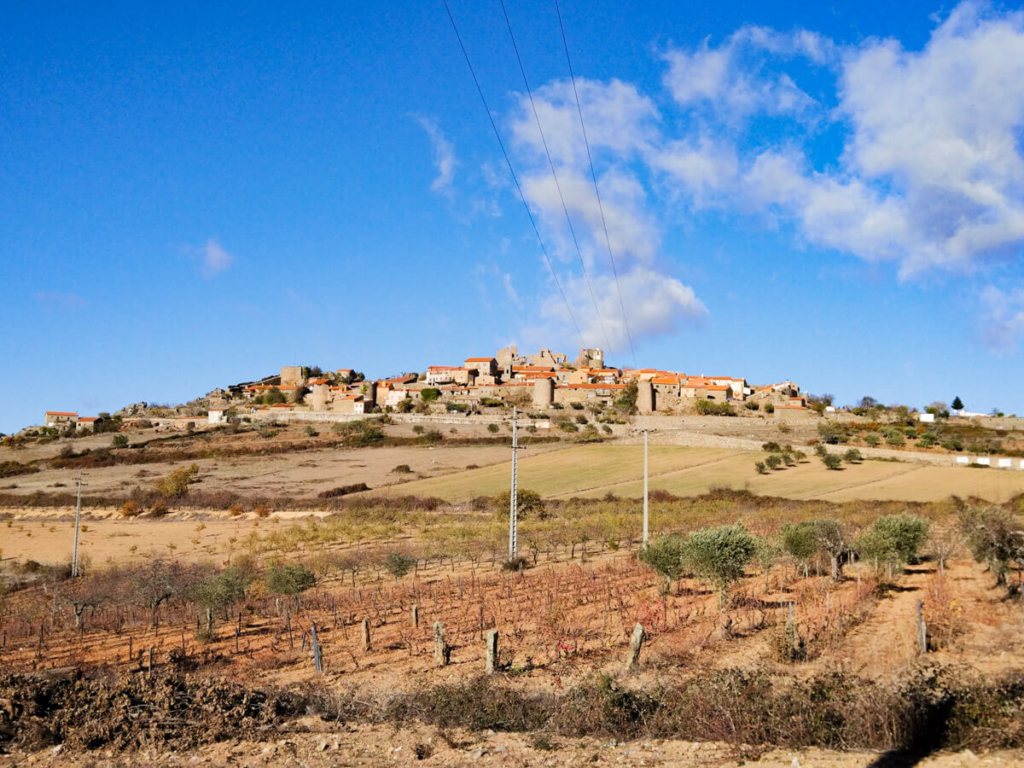
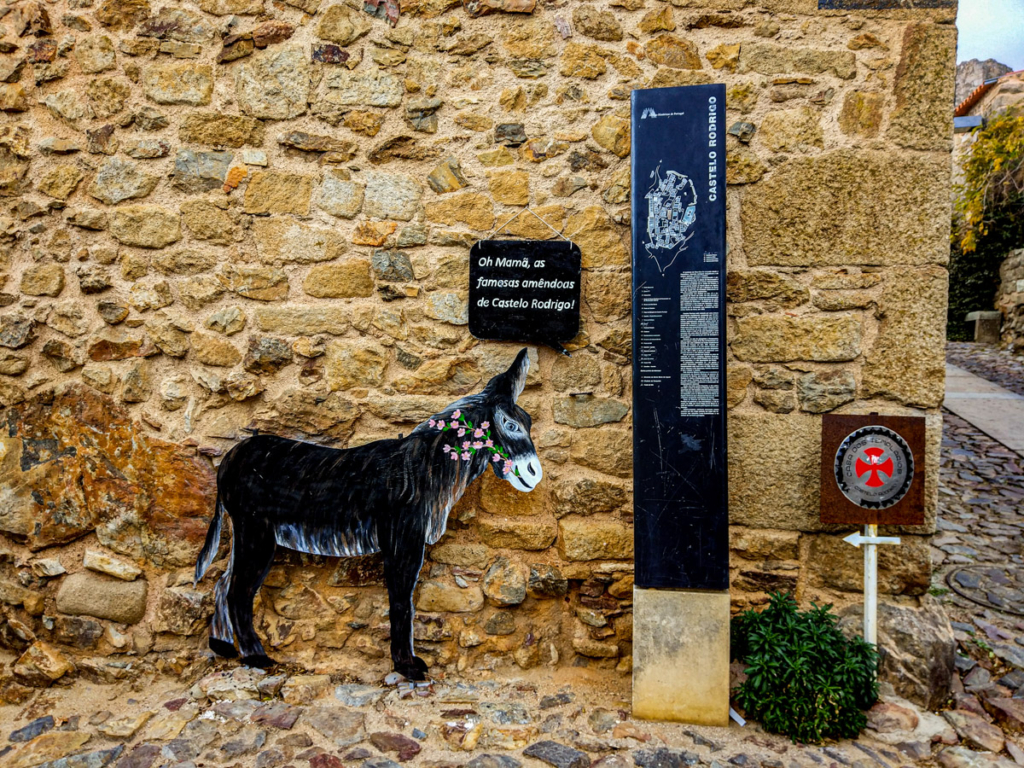
2. Other places to visit in Castelo Rodrigo
- The Community Oven of Castelo Rodrigo
- The Jail house, in the historic center, built in Manueline times and which functioned until 1836. You can still see the places where the railing used to be.
- The Manueline window in Rua da Cadeia.
- The Rabbi’s House, on the façade of which you’ll find one of the symbols of Judaism: a five-pointed star.
- The medieval Jewish Quarter and Castelo Rodrigo Synagogue. It is believed that this synagogue functioned not only as a place of worship but also as a Mikwéh (for liturgical baths). It was later also a 13-meter-deep cistern when the Jews were expelled from the Iberian Peninsula.
- The remains of the Albarran Tower.
- The Clock Tower, added to the wall next to the old barbican.
- The Town Hall and the House of Mercy.
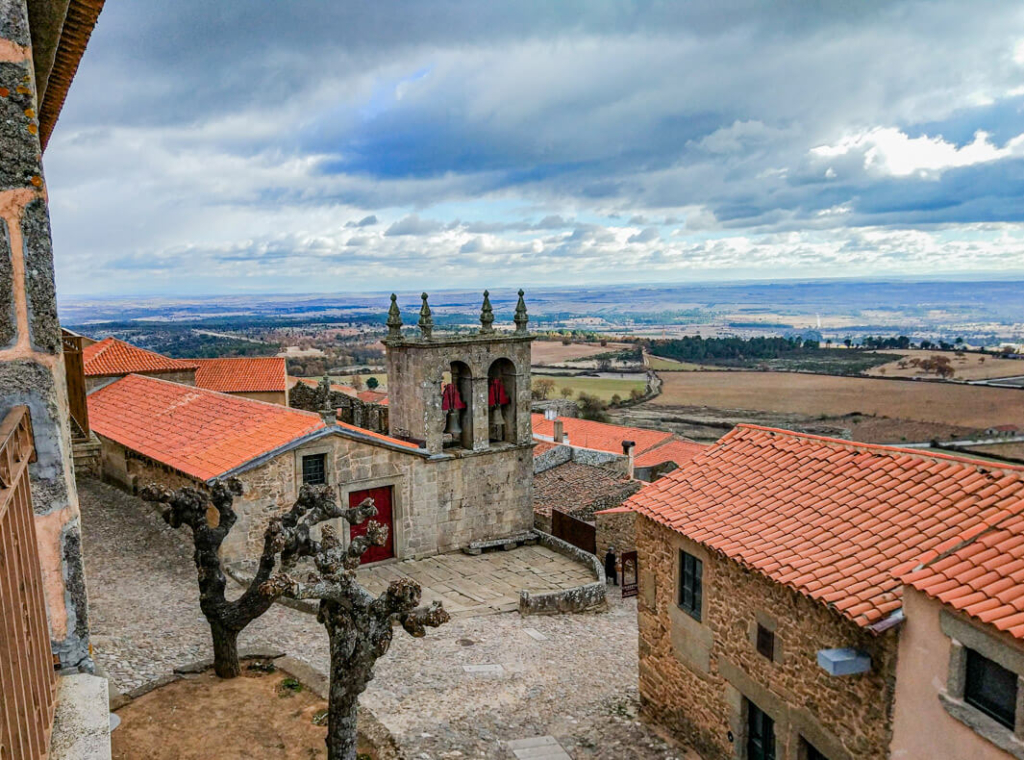
3. Places to visit in the outskirts of Castelo Rodrigo
- Cristo Rei da Marofa, for exceptional views.
- The Gardens of Figueira de Castelo Rodrigo and the Mother Church.
- The Tower of Almofala. It is believed to have had a Roman foundation and was initially used as a temple. You can visit a small Interpretive Center next to it, but you should first contact Figueira de Castelo Rodrigo tourist office.
- The viewpoint of the Chapel of Santo André das Arribas, overlooking River Águeda, on the border with Spain. Access is terrible with a dirt road in bad condition, but the view is totally worth it. Ideally, you should take the trail that leads there from Almofala Tower.
- Alto da Sapinha viewpoint
- And the Roman bridge of Ribeira de Aguiar in Escalhão.
With more time, of course, you could head north to Barca d’Alva, near Douro river, crossing the border to do one of the best trails I’ve ever done: Camino de Hierro, or Route of the Tunnels and Bridges of La Fregeneda.
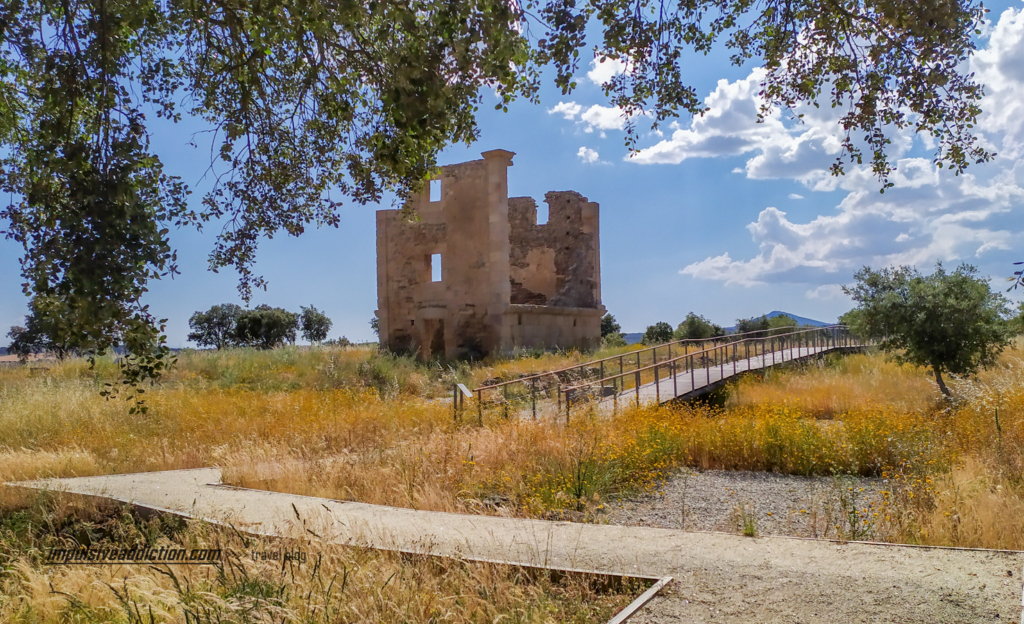
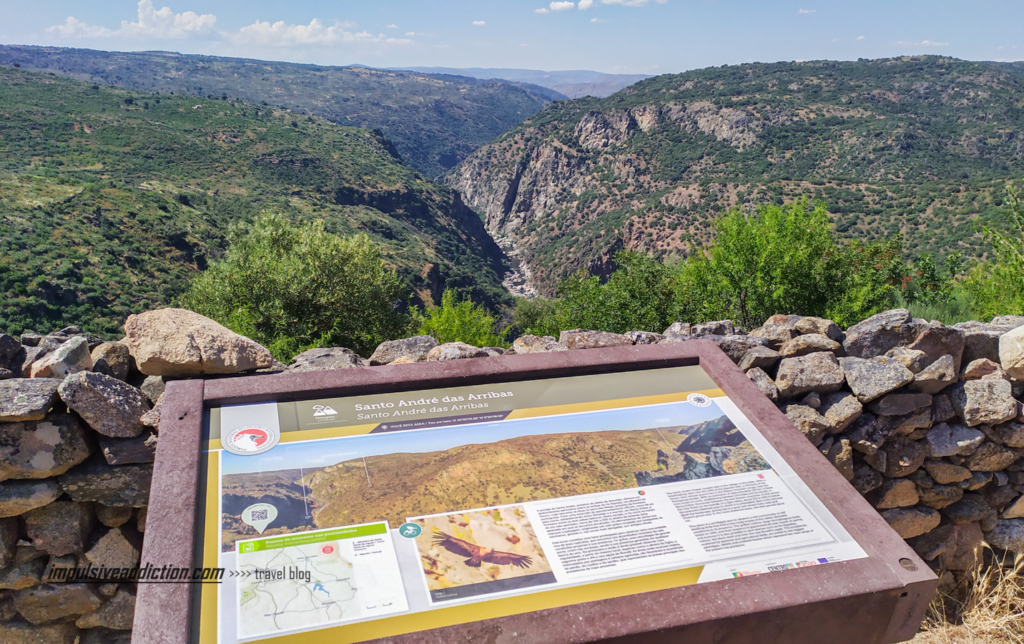
Marialva | Historical Villages of Portugal
Marialva only got its name in 1063 after it was taken from the Moors by Ferdinand the Great in the Christian reconquest. In the following centuries it was undoubtedly strategic for the kingdom and for the battles fought to defend it. It became a municipality, although it was later suppressed when Marialva was incorporated into Mêda.
Although Marialva is the highlight of your visit to Mêda, there are other tourist attractions not to be missed in the municipality, such as Longroiva, which also has a castle. You can consider Longroiva as an extra village to visit on this itinerary, and I’ll tell you what there is to see. 😉
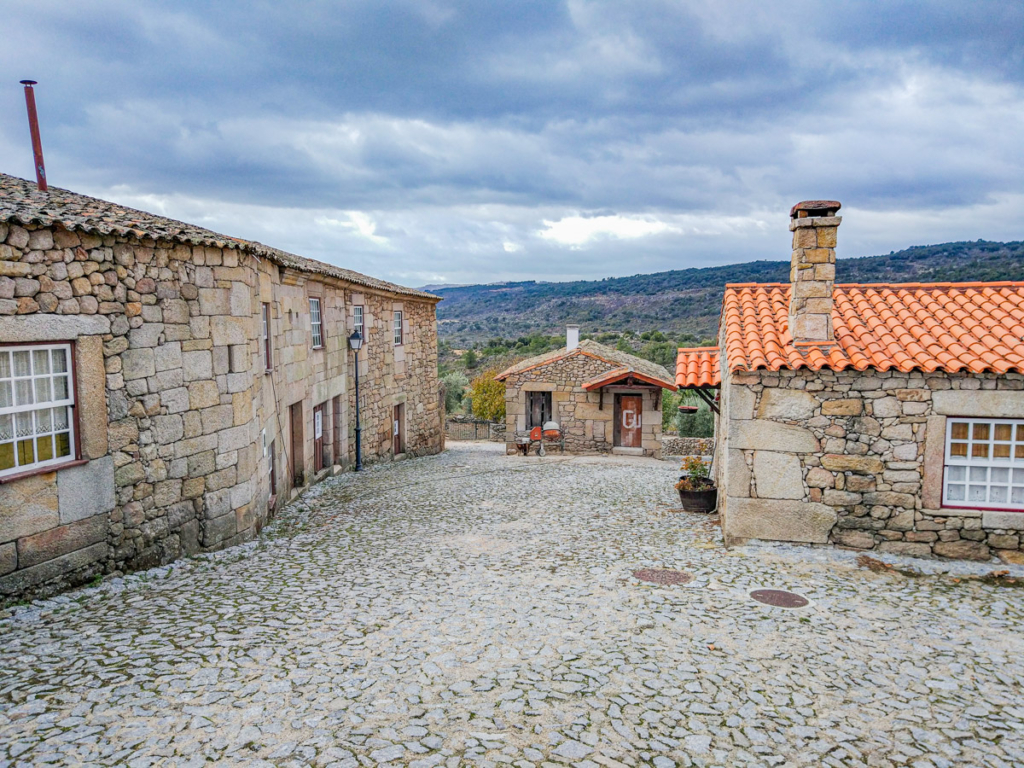
1. Must-see places to visit in Marialva
- Santa Bárbara Chapel – with a spectacular view of Devesa (the lower part of the town of Marialva).
- The ruins of Marialva Castle, whose history dates back to the 11th century, when it was conquered by Ferdinand the Great. Its gates stand out, namely Portas do Monte, do Anjo da Guarda, de Santa Maria and do Postigo (or da Traição). The second was the main one in the walled town and was also called Porta de São Miguel. They all arose from reforms during the reign of King Dinis in the 13th century.
- The old town hall of Marialva, in ruins. It dates back to the 17th century and functioned as an elementary school in the 19th and 20th centuries.
- Marialva Pillory, from the 16th century.
- The Chapel of Senhor dos Passos and the Church of Santiago, side by side. The first dates back to the 17th century and has beautiful paintings in coffered ceilings. The second has Romanesque inscriptions from the 12th century, so you can tell it’s very old. It was altered in the 16th century and also has some Manueline details.
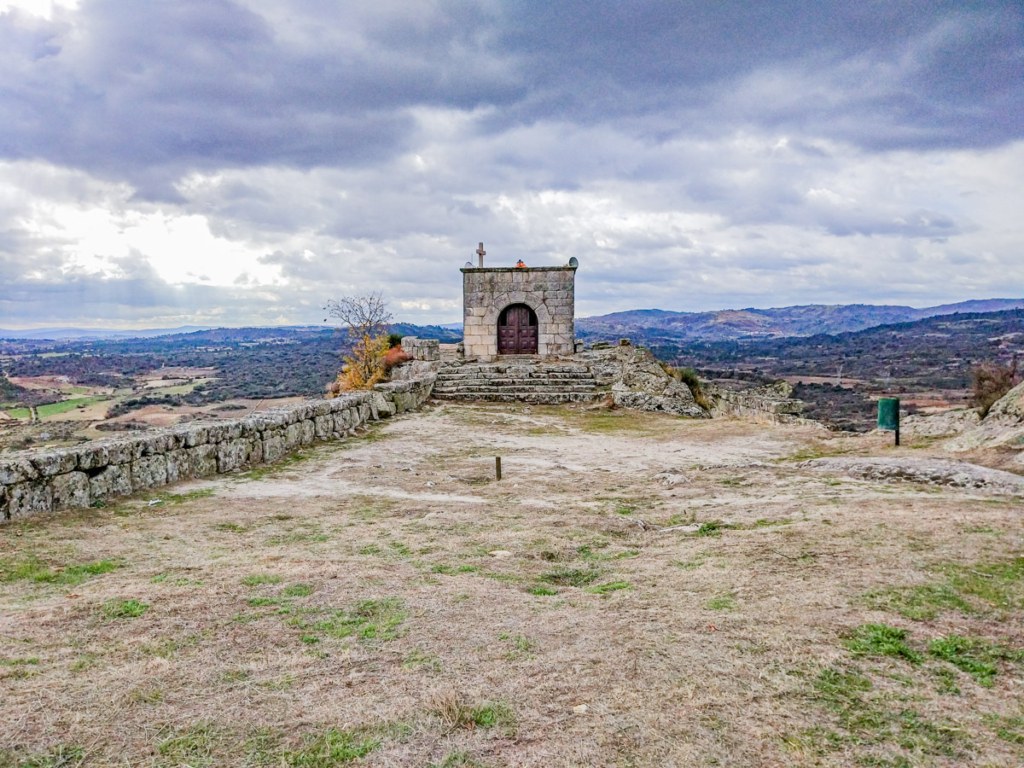
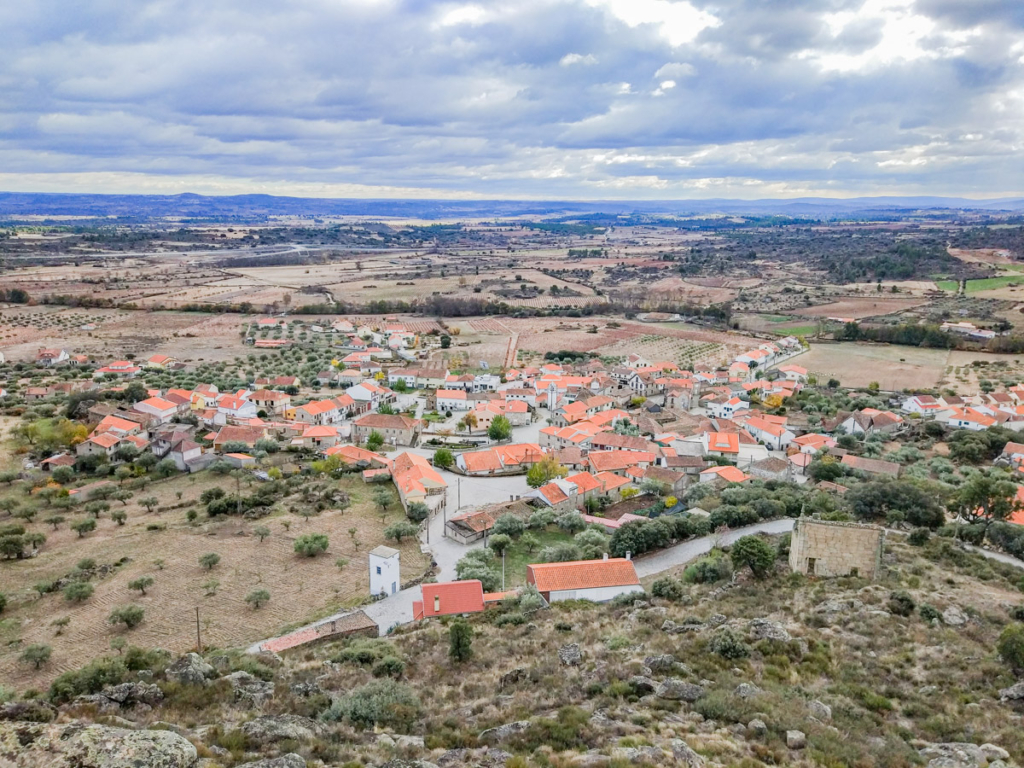
- The Chapel of Nossa Senhora da Lourdes or São João Baptista. It stands next to the Guardian Angel Gate and possibly dates back to the 17th century.
- The Campanile of the Old Church of São João, integrated into the wall. It is what remains of an old church in this historic village, dating back to the 13th century.
- The graves dug into the rock in the vicinity of the two previous points.
- Marialva Cistern (16th century), used to supply water to the population.
- Marialva Cross, from the 15th century.
- The Church of São Pedro, associated with the Order of Christ. Its interior is beautiful, with murals, extraordinary coffered ceiling paintings (18th century) and gilded woodwork on the altar.
- The Church of Nossa Senhora da Guia, just outside the village.
- And some of the town’s historic houses, such as the Solar do Marquês, the Jewish Houses, the Lion House, and the former granary of the village of Marialva, which was also a church.
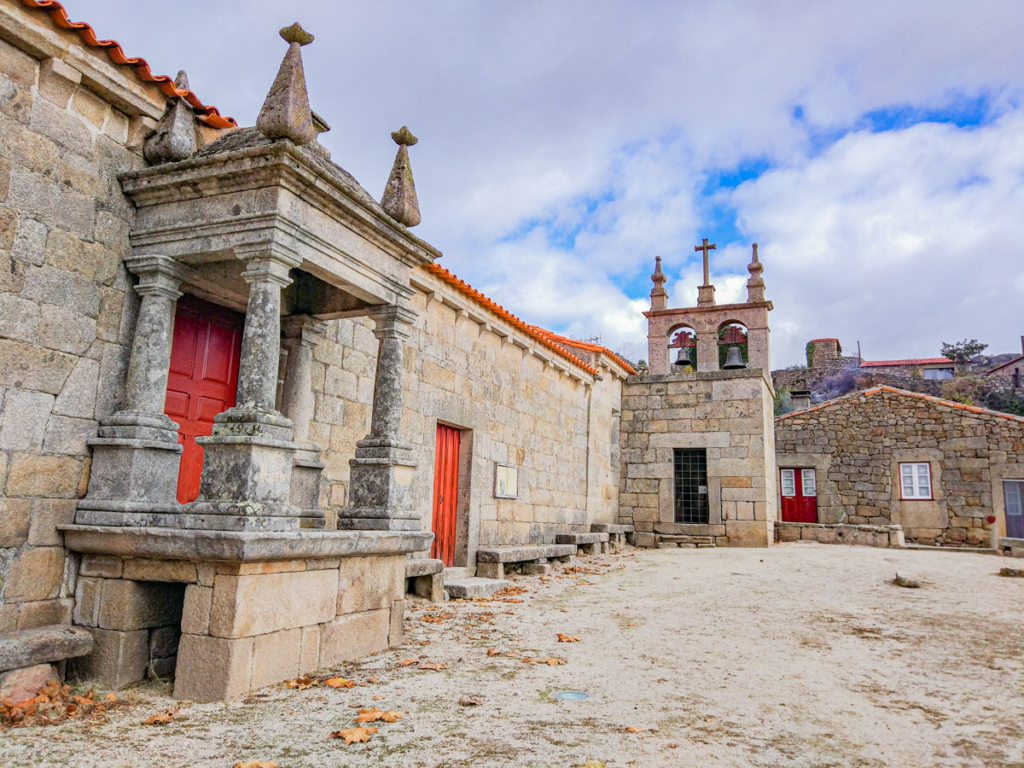
2. Surroundings of Marialva – Mêda, Longroiva and Ranhados
- Visit Longroiva Castle, with one of the oldest keep towers in Portugal. Don’t forget the Church of Nossa Senhora do Torrão and Longroiva Thermal Baths, recommended for treating respiratory, rheumatic and musculoskeletal diseases.
- In Mêda, in addition to the Clock Tower, you should at least visit the Mother Church and its beautiful square.
- Visit Ranhados Castle, the pillory, the Mother Church and the Chapel of Nossa Senhora de Guadalupe. You can also go to the Ranhados Dam.
- Visit Vale do Mouro Archaeological Site with ruins that began to be excavated in 2003. Traces have been found from Roman times, but also from Neolithic settlements 7,000 years ago.
Penedono | Extra on the Route of Portugal’s Historic Villages
I confess I haven’t visited Penedono yet, but I think it could definitely be an extra to your visit to the 12 official historic villages of Portugal. If you want to get to know Penedono, visit the town hall’s website to find out what to see there.
Trancoso | Historical Villages of Portugal
When I began my tour of Portugal’s Historical Villages, it was Trancoso that was the starting point. Speaking a little about the history of Portugal, Trancoso had a prominent place, since at the time of King Afonso Henriques (12th century), it was one of the main settlements in the region.
It was an important trading center and was also a strategic location for several battles, some of which were between Portugal, Spain and even France.
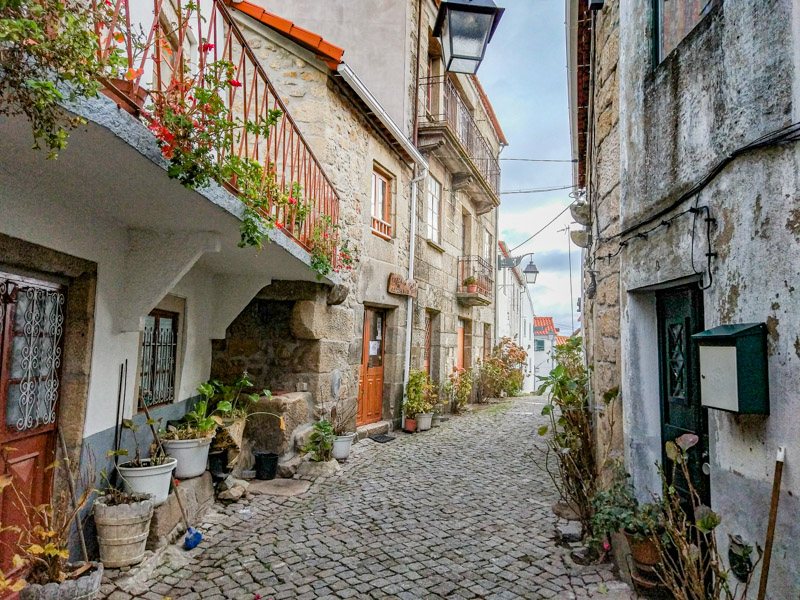
1. Must-see places to visit in Trancoso
- Portas de El Rei, in honor of King Dinis, who celebrated his wedding in Trancoso. There were a total of four main gates in the walled enclosure, but only three have survived to this day: the aforementioned El-Rei gates, the Prado gates (also imposing) and the Oak Gate. There are also two secondary gates, Porta da Traição and Olhinho do Sol.
- The Chapel of São Bartolomeu, rebuilt in the 18th century, but probably originated in the 13th century, also as a commemoration of the royal wedding of King Dinis to Queen Santa Isabel.
- The Chapel of Santa Eufémia, from the 18th century, was built with donations from the local population.
- The Trancoso Municipal Botanical Park.
- The remains of the former Convent of the Friars, founded by the Third Order of São Francisco in the 16th century. In 2009, the church was converted into the Trancoso Municipal Theater.
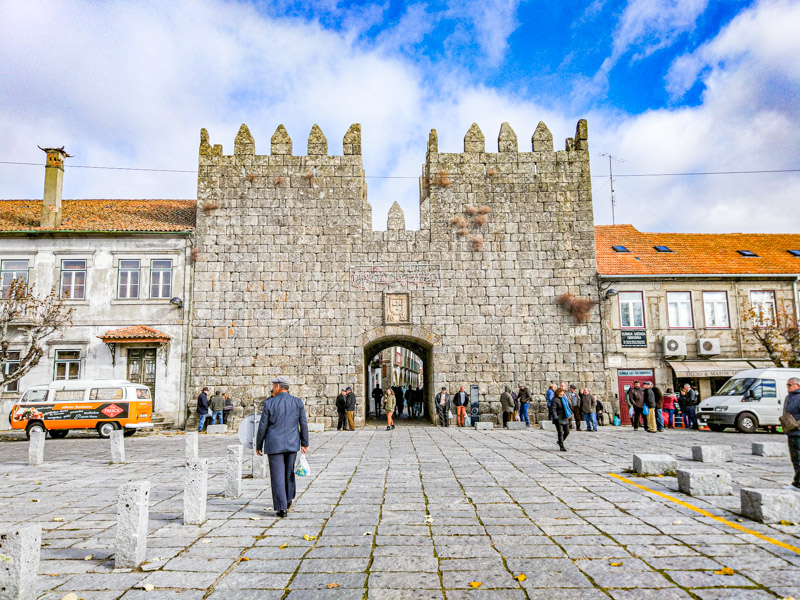
- Trancoso Castle. It already existed in the 10th century, but it’s not known for sure when it actually appeared. The keep dates from this period and is still well preserved. Inside the castle grounds you’ll find an old cistern that used to supply water.
- The Barbican, built during the reign of King Ferdinand in the 14th century. It was the Castle’s first line of defense, and only a section remains between the two secondary gates mentioned above.
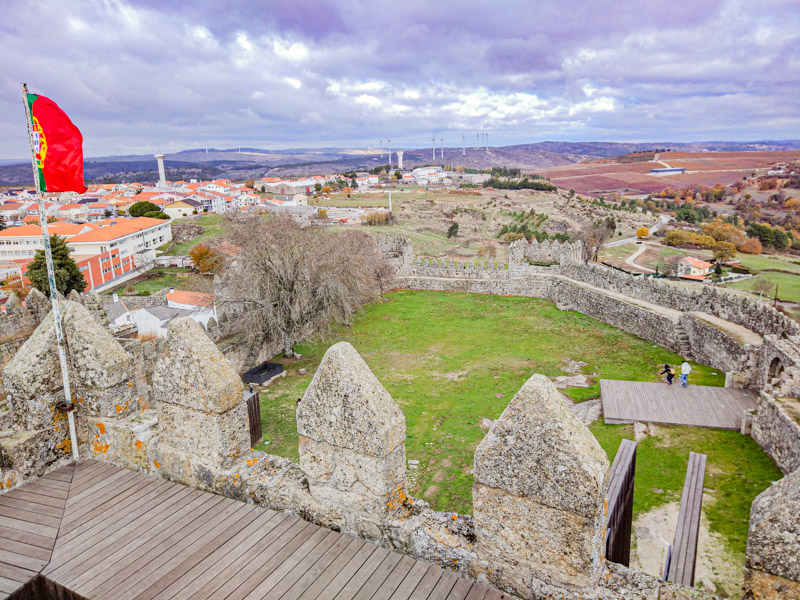
- Trancoso’s pillory.
- The Church of São Pedro, which houses the mausoleum of the prophet Bandarra, who was buried there in 1545.
- Bandarra House, a museum about the prophet.
- The Misericórdia Church, founded in the 16th century.
- Casa dos Arcos, with traces of an old market being held there.
- The Old Town Hall, which also served as a jail, dating back to the late 15th century.
- The House of the Post Office and the Sousas Manor House, both emblazoned.
- And Beresford House, headquarters of the Luso-British troops during the French invasions.
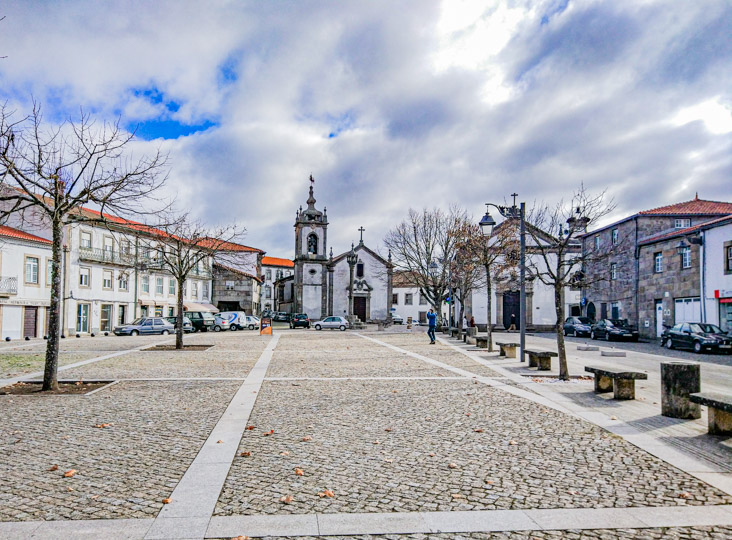
- Trancoso’s Jewish Heritage, with a visit to the Black Cat House, the Master’s Well and the House of Jewish Culture, with various exhibitions on the subject.
- The Ducal Palace of Trancoso, which dates back to the 18th century and was the residence of viscounts (and not dukes, as the name wrongly suggests).
- The huge linden tree that stands next to the Ducal Palace, in the square of the Church of Santa Maria de Guimarães. It’s more than 22 meters high.
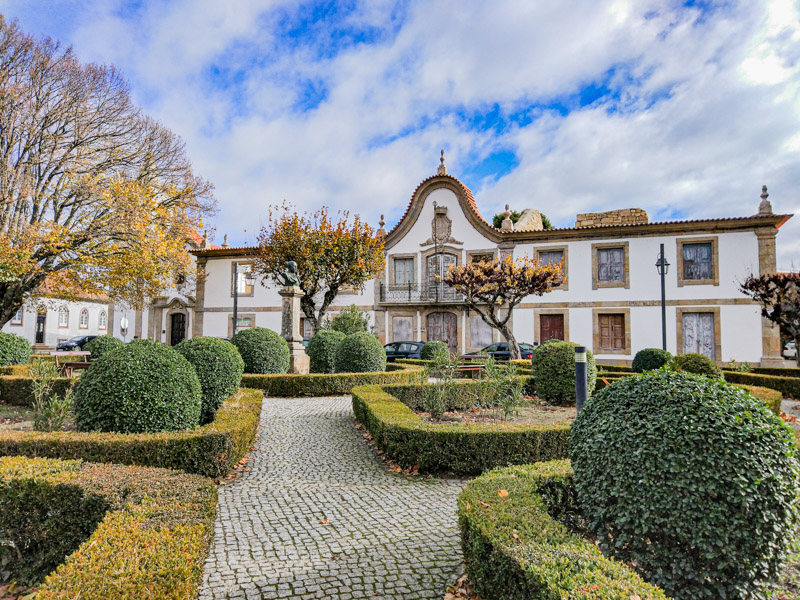
2. Other places to visit in Trancoso and surroundings
- Solar dos Morgados do Terrenho.
- The Town Hall of Trancoso (a building from the first half of the 20th century).
- The emblazoned House of Olives.
- The Church of Nossa Senhora da Fresta, from the 12th century.
- Trancoso Cultural Center
- Trancoso’s New Fountain
- The Chapel of Santa Luzia
- The Chapel of Senhor Jesus da Calçada
- The Chapel of São Marcos on the site of the Battle of Trancoso. This is supposedly where the battle of 1385 took place, in which the Portuguese army defeated the Castilian army, led by the mayor of Trancoso (Gonçalo Vasques Coutinho).
- The Visigothic tombs and the medieval rock-cut graves.
- The village of Moreira do Rei, especially the Church of Santa Marinha and the Castle Ruins.
- And Póvoa do Concelho swing, with a pleasant viewpoint.
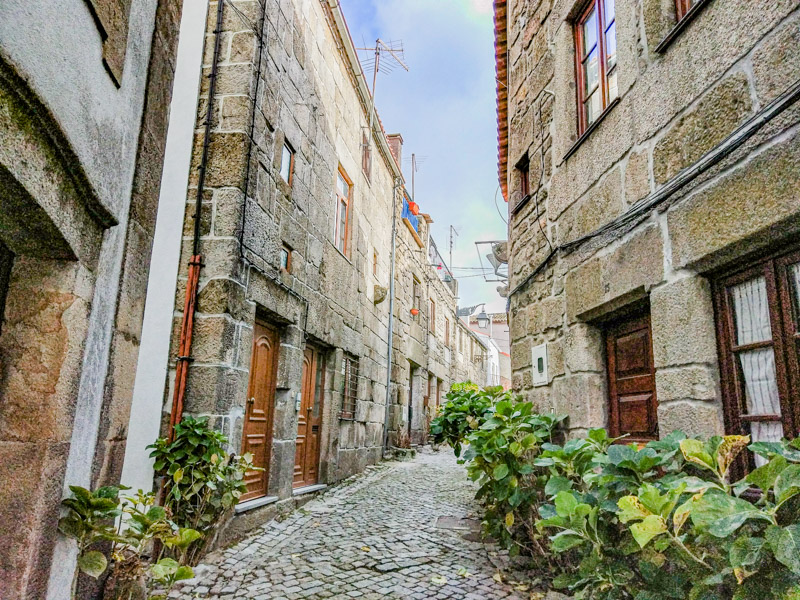
Linhares da Beira | Historical Villages of Portugal
Linhares da Beira was once strategic as part of the defensive system that guarded the Mondego river area. The castle is the main reason to visit the village and dates back to the 13th century. It is considered the capital of paragliding.
1. Must-see places to visit in Linhares da Beira
- Linhares da Beira Castle – 800 meters above sea level and dating back to the 13th century. It has 2 towers (the Keep and the Clock Tower), 4 gates and 2 cisterns, and has been a national monument since 1922.
- The Mother Church of Linhares da Beira – dedicated to Nossa Senhora da Assunção, was built over an earlier church dedicated to Santa Maria. It underwent major alterations in the 17th and 18th centuries, and then acquired the appearance it has today. In the vicinity of the church, don’t forget the São Caetano Fountain.
- The Church of Misericórdia – The Romanesque details still visible on the church’s side portal stand out. This church became home to the Misericórdia in the 16th century and is also known as the Church of Santo Isidoro.
- The 16th-century pillory, which was erected following the granting of the town’s Manueline charter in 1510.
- The ancient Roman road, part of the road that connected Mérida to Bracara Augusta (Braga).
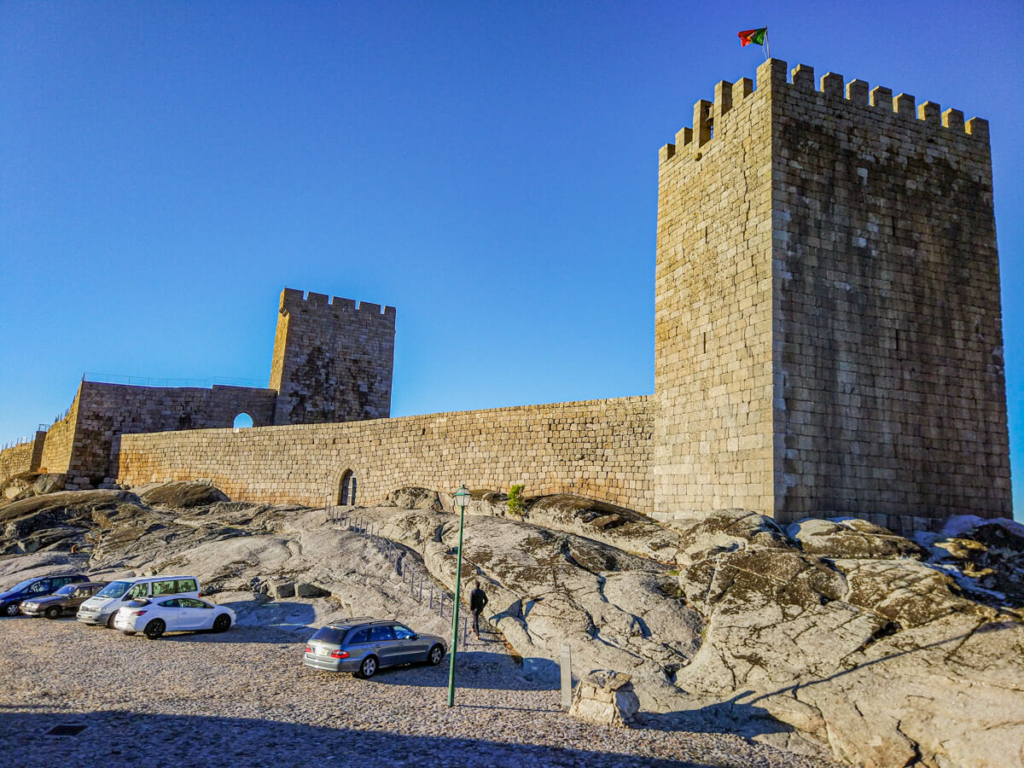
2. Other places to visit in Linhares da Beira
- The Chapel of Nossa Senhora da Conceição.
- The Old Town Hall and Jail. As the name suggests, it served as a jail in the past, but was later used as a school and teachers’ residence, and today houses the Linhares da Beira parish council.
- The old Hospedaria, which was also the Misericórdia hospital and a support center for the most disadvantaged and pilgrims.
- The village fountains.
- And the charming historic streets.
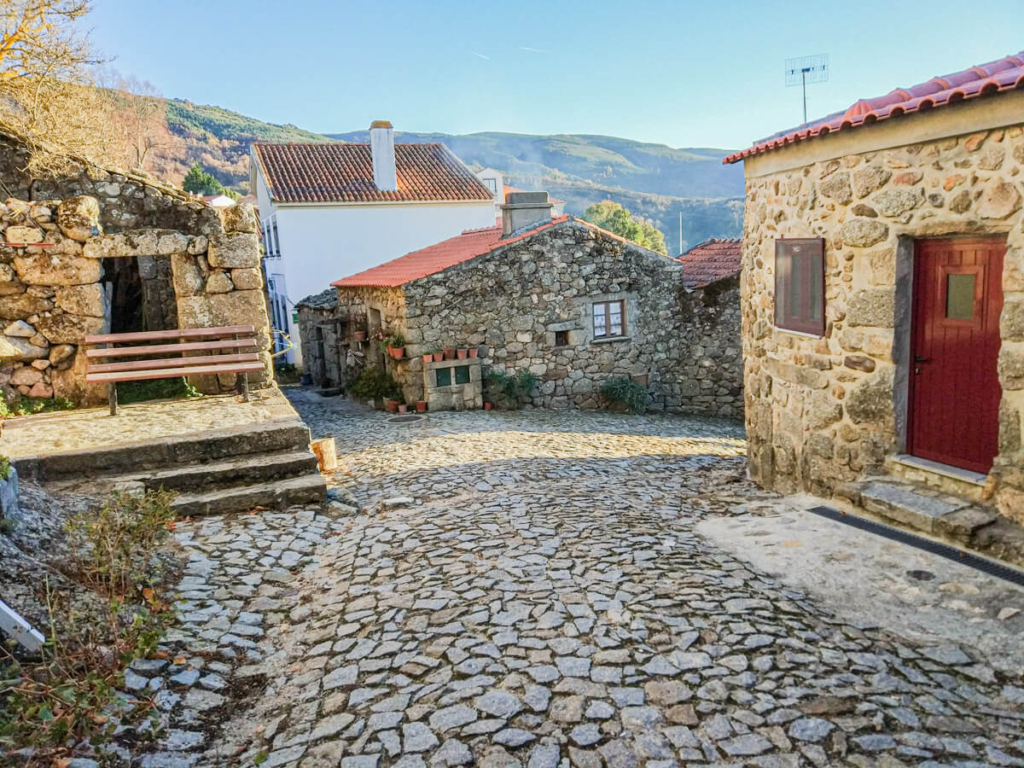
3. Around Linhares da Beira – Celorico da Beira
- Celorico da Beira Castle – built in the 12th-13th centuries. It has two entrance gates and a tower, but the original keep was located in the center of the square. You can walk on the ramparts to admire the beautiful view of the fields and mountains surrounding the town.
- Solar do Queijo, in Celorico da Beira, and the Farmer and Cheese Museum.
- The Mother Church of Santa Maria, with two bell towers and origins in the 13th/14th centuries. The interior is well worth a visit!
- The Misericórdia Church, built between the 17th and 19th centuries.
- The Church of São Pedro.
- The Clock Tower – the clock itself stands out, as it wasn’t always found here but was once in the castle. It is believed to have existed at the beginning of the 17th century, but its origins may be earlier. It’s a clock powered by stone weights!
- The Lavandeira Bridge
- The Necropolis of São Gens and Penedo do Sino.
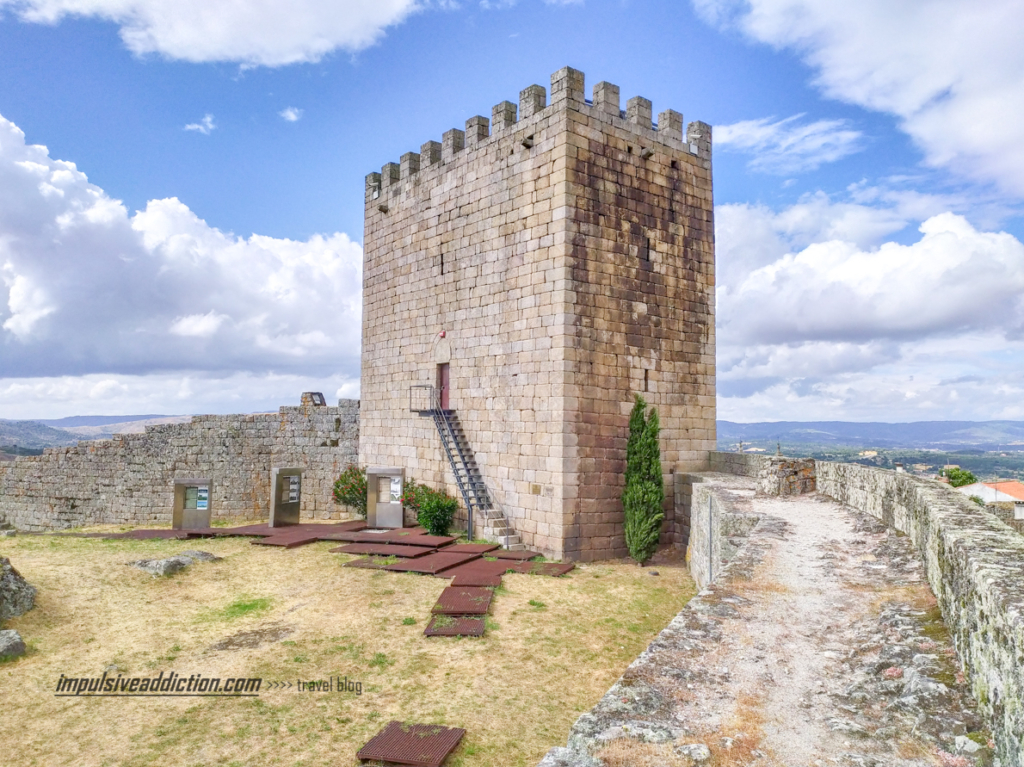
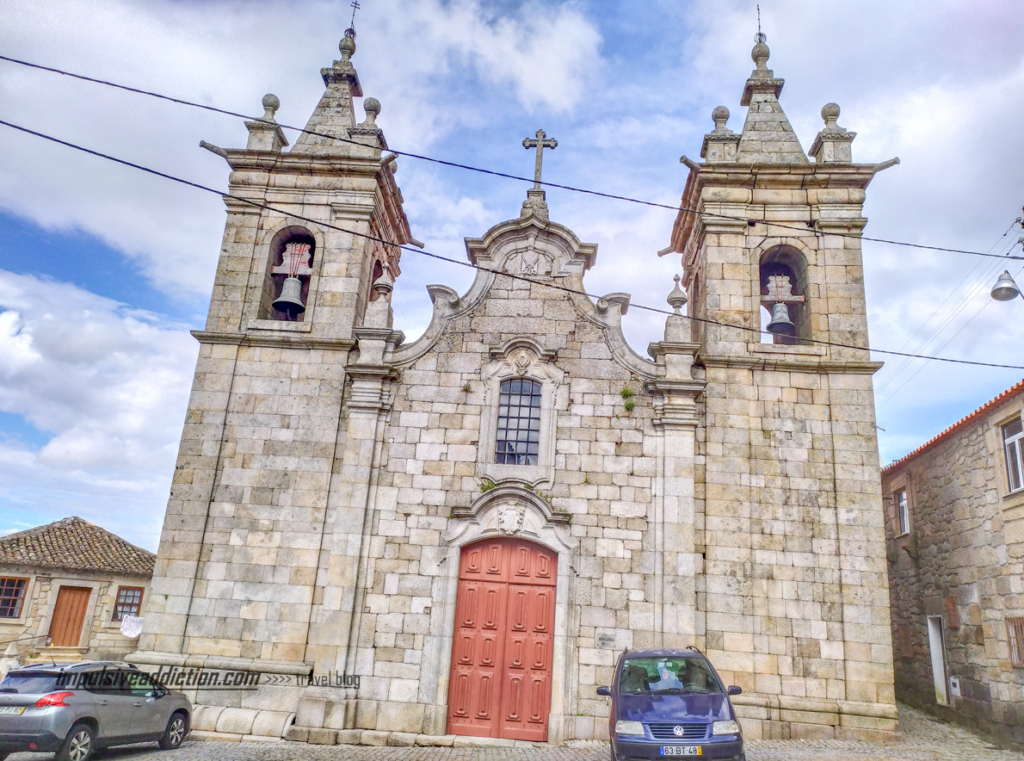
4. Around Linhares da Beira – Folgosinho
I also really liked Folgosinho, in the heart of Serra da Estrela. Climb up to its castle, visit the Mother Church and the Chapel of São Faustino, and discover its fountains and pillory. Read the poetry scattered around the village.
Piódão | Historical Villages of Portugal
Piódão is one of Portugal’s 12 historic villages, but it is also one of Portugal’s schist villages. It won the remote villages category for the 7 wonders of Portugal.
In Serra do Açor, near Piódão, there are several mountain trails that you can follow, and through them you can visit other equally incredible places, including fantastic and desirable river beaches and even waterfalls. Have you heard of Foz de Égua and Chãs de Égua?
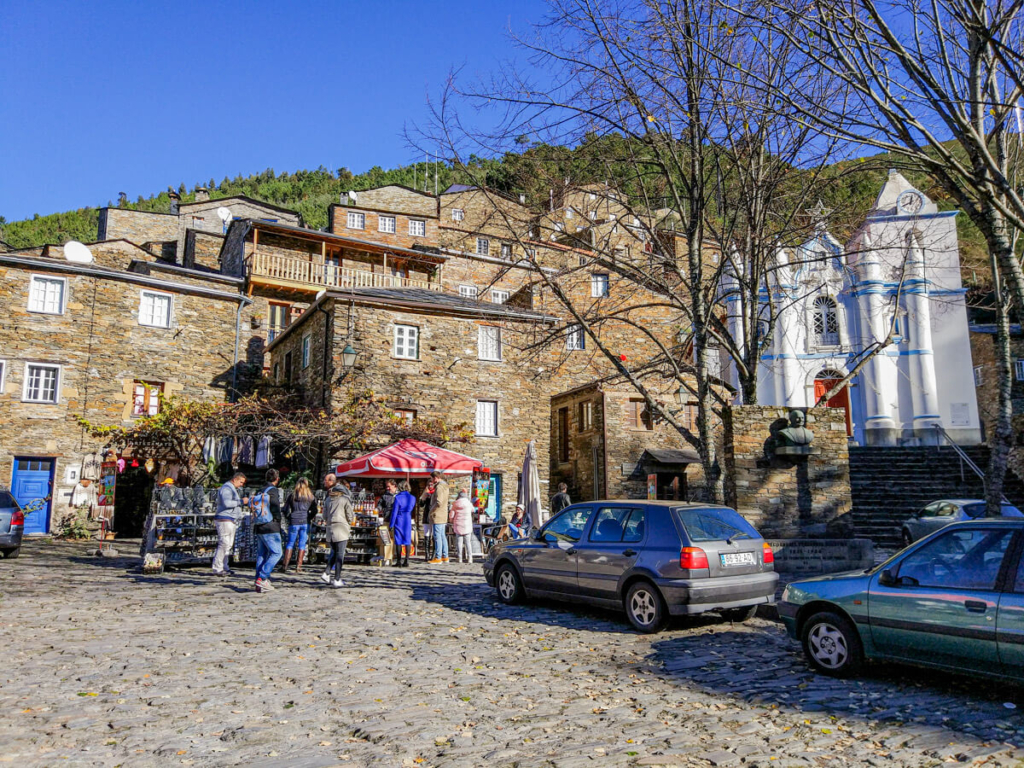
1. Must-see places to visit in Piódão
- The Mother Church of Piódão, of Nossa Senhora da Conceição, built in the 17th century. It is undoubtedly the exterior that is most impressive, but inside you’ll find a limestone image of the patron saint (16th century), as well as images of Our Lady of the Conception, Saint Michael and Saint Sebastian.
- The Church of São Pedro (simple in layout, but with an image of São Pedro from the 16th century), and the Chapel of the Souls, founded in the 18th century and dedicated to the Souls in Purgatory, having served in the past as a mortuary chapel.
- Piódão Museum, located in Cónego Manuel Fernandes Nogueira square. It serves as the village’s tourist office, where you can find information on handicrafts, accommodation, restaurants, tourist attractions to visit, and even available walking routes.
- The bust of Canon Manuel Fernandes Nogueira, an important priest from Piódão. He was born in Loriga in 1861 and only arrived in this historic village in 1885. In Piódão he founded an important school that prepared young men for entry into the seminary: in all, more than 200 boys passed through there.
- The Community Threshing Floor, used in the past to dry and thresh the grain harvested from the surrounding fields.
- The Chapel of Nossa Senhora do Bom Parto and viewpoint.
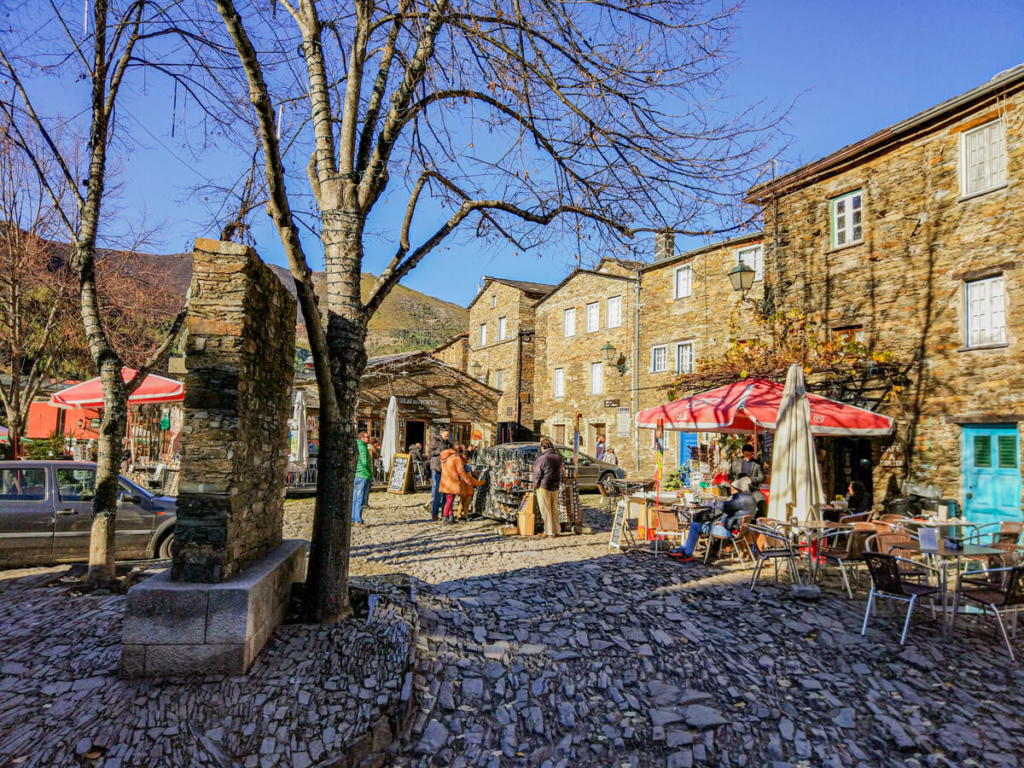
2. Around Piódão – Serra do Açor
- Foz de Égua and Chãs de Égua by trail. Great river beaches along the way, and suspended bridges and viewpoints.
- The Fraga da Pena waterfall, via the PR1 AGN – Caminho do Xisto da Benfeita. In addition to the Fraga da Pena waterfall, it follows several watercourses and levadas, and allows you to pass other smaller waterfalls. It passes through several other villages in the region where schist also predominates: Sardal, Pardieiros, Benfeita.
Castelo Novo | Historical Villages of Portugal
Castelo Novo is in Fundão region, very close to Serra da Gardunha. That’s why you’ll not only find a lot of history there, but also stunning scenery. In case you didn’t know, Fundão is Portugal’s cherry capital, so a visit during cherry season is almost obligatory.
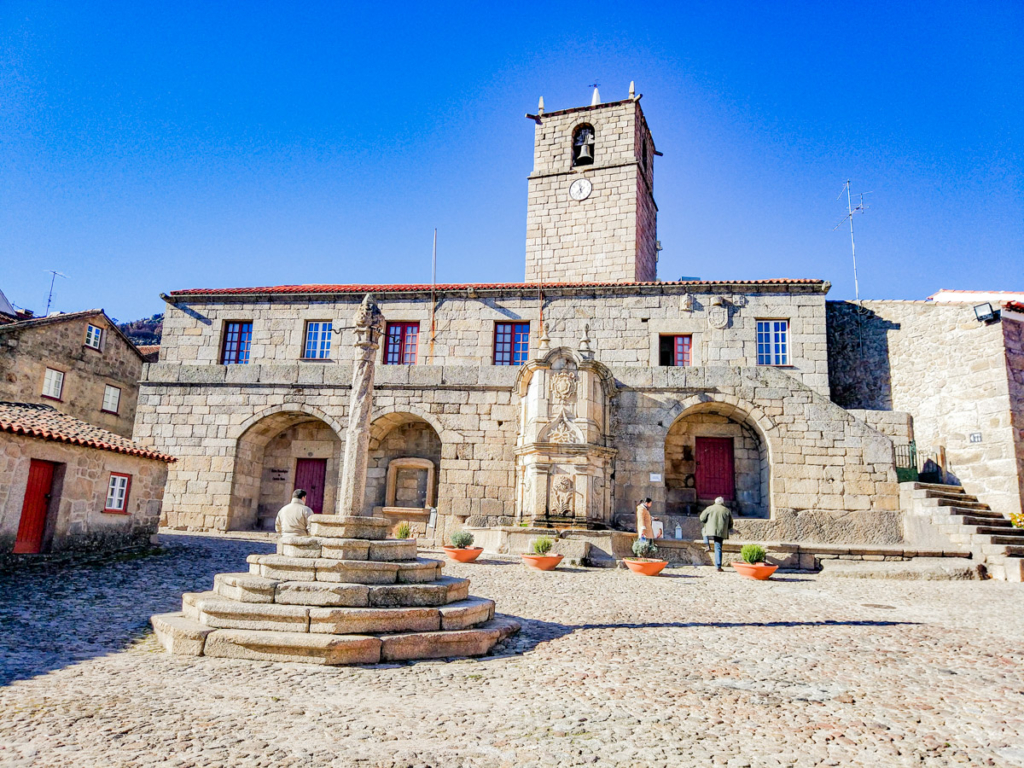
1. Must-see places to visit in Castelo Novo
- The Town Hall and Pillory Square, with the Fountain of D. João V and the Archaeological Museum.
- The pillory dates from the 16th century, in Manueline style. The Town Hall building dates back to the 13th century, during the reign of King Dinis, but was remodeled during the reign of King Manuel I. There was a jail on the first floor, and in this square, sentences were read out to criminals in public.
- The D. João V Fountain takes its name from the fact that it was built during the king’s reign. Its coat of arms stands out.
- The Castelo Novo Archaeological Center is now located on the ground floor of the Town Hall and has a collection of pieces discovered during excavations at the castle.
- El Rei Fountain, which dates back to the reign of King Dinis.
- The Bica Fountain, from the 18th century.
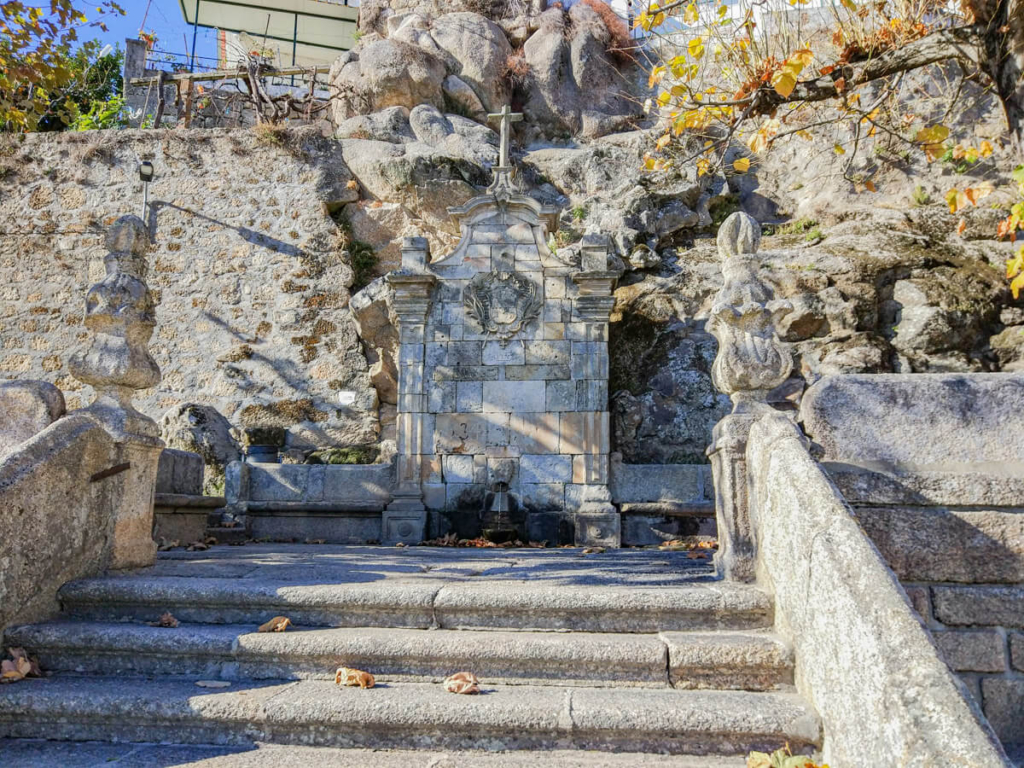
- The Castle – I’d clearly like to highlight its tower and the splendid view of the surrounding plains. The castle was built in the 12th century and abandoned in the 17th century. In the aforementioned archaeological excavations (at the beginning of the 21st century), various details of its occupation were uncovered.
- The River Beach and Leisure Area, next to Ribeira de Alpreade.
- Cabeço da Forca and Cruzeiro de Castelo Novo – As the name suggests, Cabeço da Forca was where criminals were sentenced to death. The Cross, on the other hand, was built to commemorate the 3rd Centenary of the Restoration and National Independence.
- The Chapel of Santa Ana and the Chapel of Santo António.
- The Church of Misericórdia.
- Manuela Justino Art Gallery – An art museum dedicated to the sculptor and painter Manuela Justino, with some remarkable works from the second half of the 20th century.
- The Mother Church of Nossa Senhora da Graça – in honor of the patron saint of Castelo Novo. It was built in the 18th century.
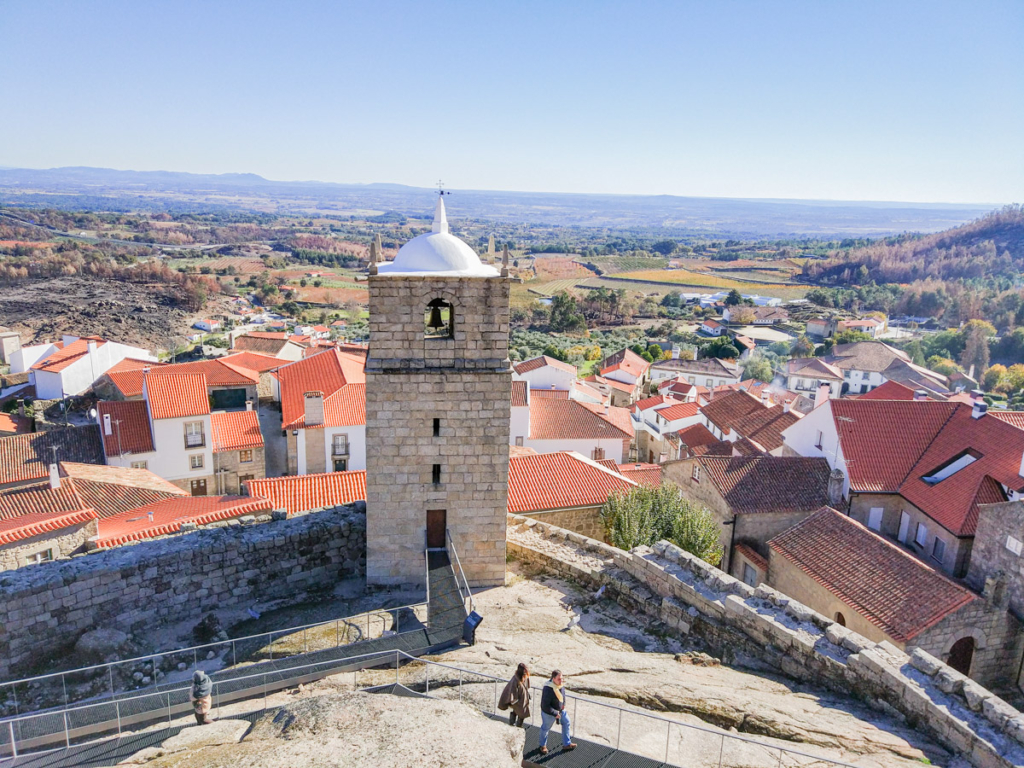
2. Around Castelo Novo – Serra da Gardunha and Alpedrinha
- Alcongosta Watchtower Viewpoint
- Old Castle Swing
- Pedra d’Hera viewpoint
- The village of Alpedrinha. Visit the Picadeiro Palace and the Mother Church, not forgetting the pillory and various other little chapels.
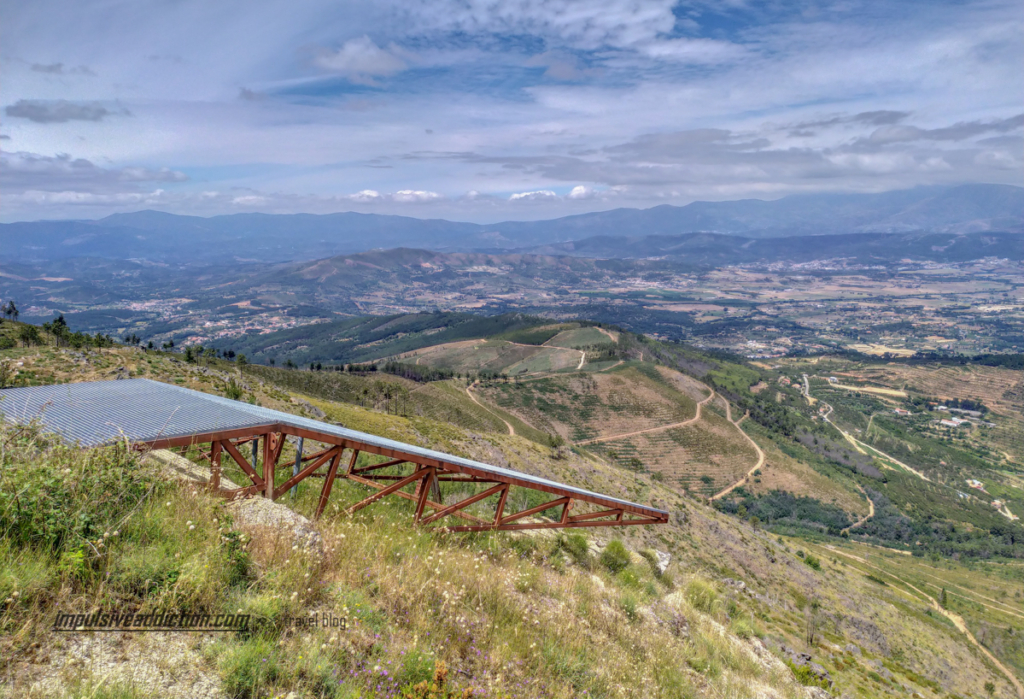
3. Surroundings of Castelo Novo – Historic Center of Fundão
- Fundão Green Park, the city’s main sports and leisure area. But there are others, such as the Tílias Park.
- Fundão Archaeological Museum, which exhibits the history of the municipality.
- Eugénio de Andrade Library, in homage to this writer and poet from the municipality of Fundão, winner of several literary prizes. The library has some of his works.
- Rua da Cale, one of the city’s main streets, with a strong connection to the ancient Jewish communities that settled there.
- The 17th century Mother Church of Fundão or Church of São Martinho.
- The Municipal Square, where Fundão Town Hall, the Pillory and a pleasant garden are located. Fundão Town Hall building was formerly used by a wool factory, dating back to the 18th century.
- The more modern Mill Building. It is the city’s main events hall, with a 140-seat auditorium, and is geared towards the performing arts. It has an interpretation center with the cereal processing circuit.
- The urban art murals, including Bordallo II’s “Wolf”.
Idanha-a-Velha | Historical Villages of Portugal
The visit to Idanha-a-Velha is a quick one. It is a nice village, but for me it’s far from being one of the most extraordinary on this tour of Portugal’s 12 historic villages. Idanha-a-Velha is the ancient Egitania of the Visigothic period, dating back to the 1st century BC!
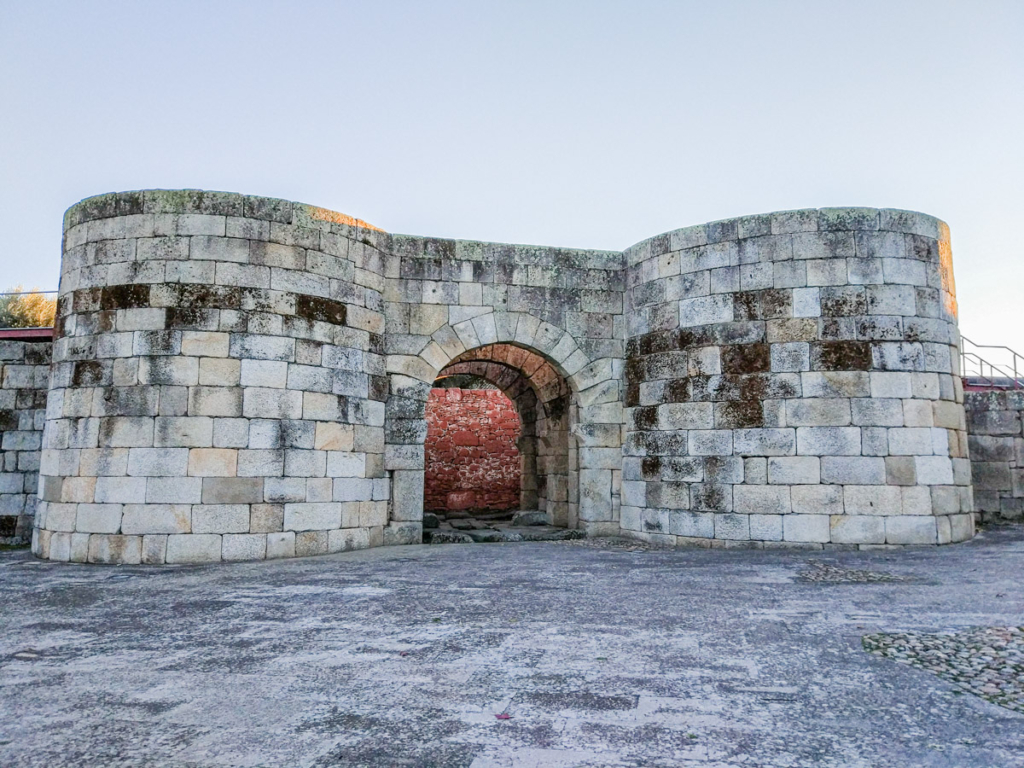
1. Must-see places to visit in Idanha-a-Velha
- The main gates to the walled village: the North and South Gates. Idanha-a-Velha has had walls since Roman times, 3rd/4th centuries AD.
- The surrounding ruins of the Church of Santa Maria. There are various theories about the origin of the church, but no certainties yet: it could have been a Visigothic work, or even a mosque that was later converted into a Christian temple. Either way, it’s very old! Don’t miss the Baptisteries, a legacy of ancient Egypt.
- The Mother Church of Idanha-a-Velha and the pillory.
- The Epigraphic Archive, with one of Portugal’s largest collections of Roman epigraphy. Many of the pieces in this collection are on display for visitors.
- The old olive oil mill, or Lagar de Varas, now home to the tourist office. It is believed to date from the end of the 19th century, but there are traces of an earlier mill on the same site. It consists of three rooms that show the olive oil production process.
- The “Big House” or Manor House of the Marrocos Family – dates back to the 20th century and was owned by the most important family of the time. This family worked in agriculture, so this house served as the center of a kind of rural estate that they owned.
- The old bridge of Roman origin
- The chapels of Idanha-a-Velha: the Chapel of the Holy Spirit, the Chapel of São Sebastião and the Chapel of São Dâmaso.
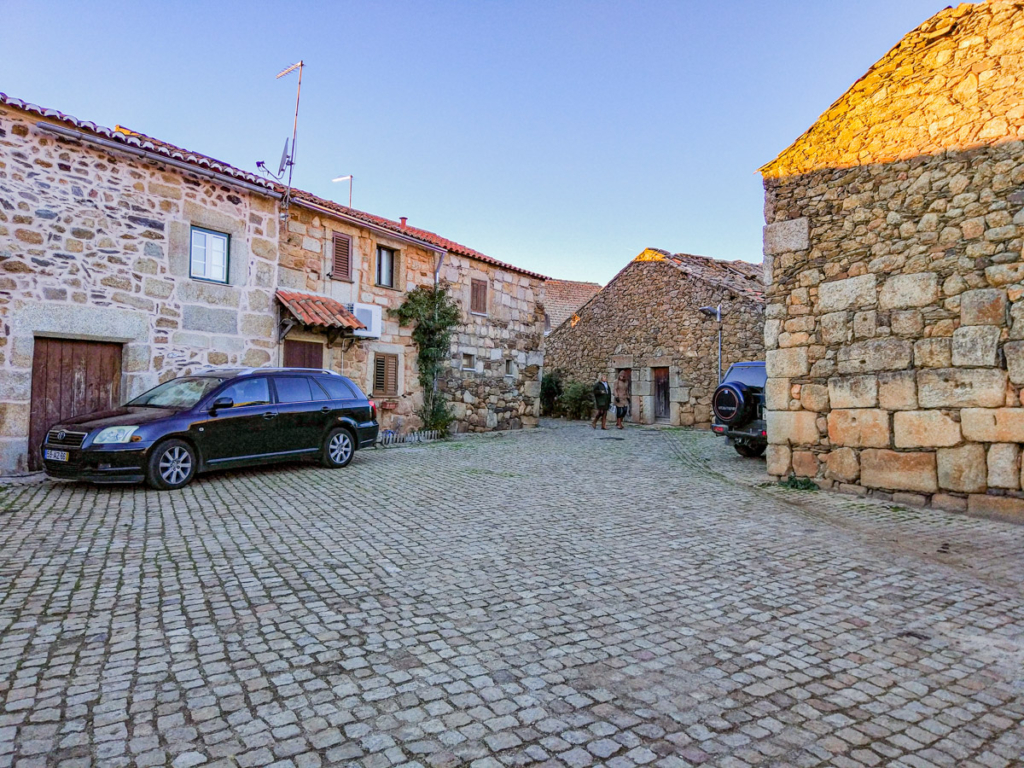
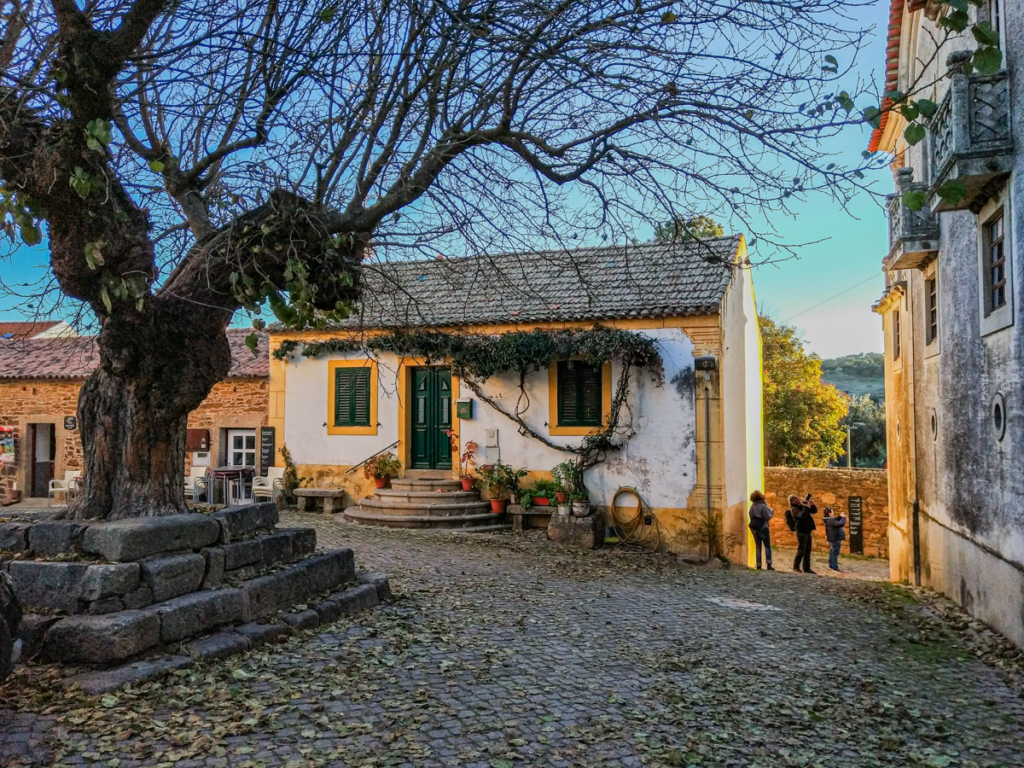
2. Visit Idanha-a-Nova
- Idanha-a-Nova Castle and the Mother Church of Nossa Senhora da Conceição.
- The Convent of Santo António.
- The Chapel of Nossa Senhora das Dores, S. João, S. Jerónimo and Senhora da Graça.
- Barroco do Boieco.
Monsanto | Historical Villages of Portugal
Monsanto is one of my favorite historic villages in Portugal. It is also considered to be the most Portuguese village in Portugal, a title that almost in itself invites us to visit it.
Speaking a little about the history of the region, it is a very old place, as traces of human presence have been found since the Paleolithic period. Monsanto was conquered from the Moors by the first king of Portugal in 1165, who soon after donated the village to the Knights Templar, who in turn had the castle built.
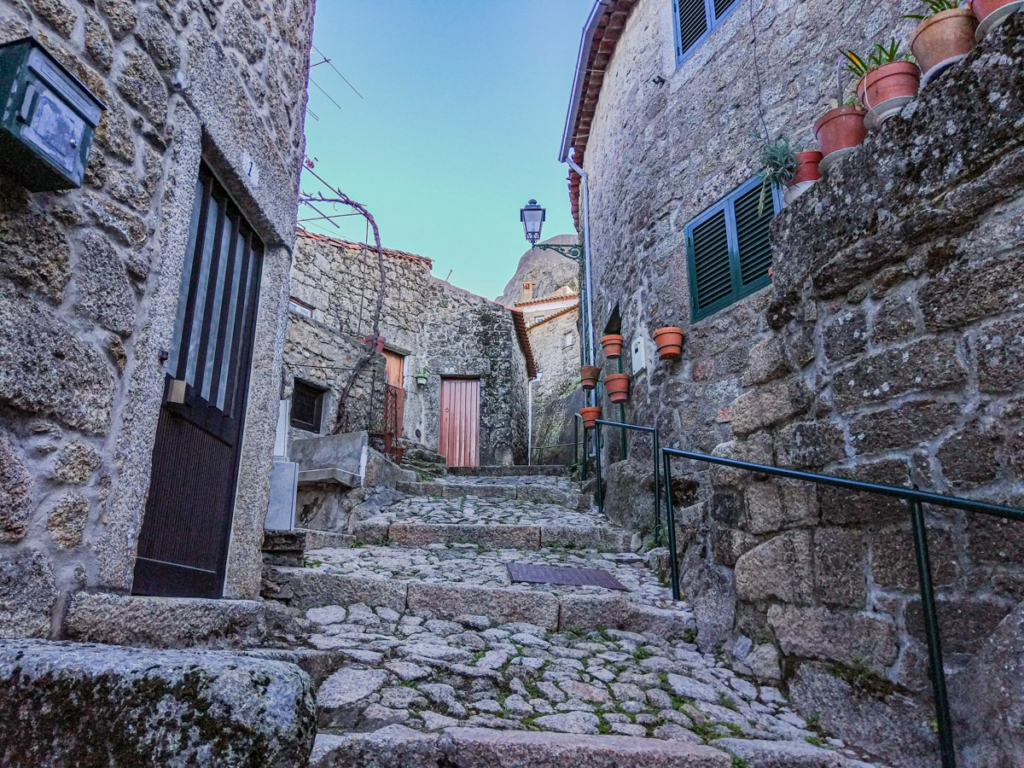
1. Must-see places to visit in Monsanto
- The Castle of Monsanto, which stands at an altitude of 758 meters. Up there you will find several attractions to visit:
- The ruins of the Chapel of São João. It was still functioning as a parish church in the 18th century.
- The ruins of the Church of São Miguel, which dates back to the end of the 12th century.
- The Castle Well, wrongly known as the Cistern. In medieval times it was the main water supply inside the fortress.
- The Church of Santa Maria do Castelo, from the 18th century.
- Peão Tower, deliberately destroyed by the town at the end of the Middle Ages because it was considered a threat to the castle itself in the event of a siege.
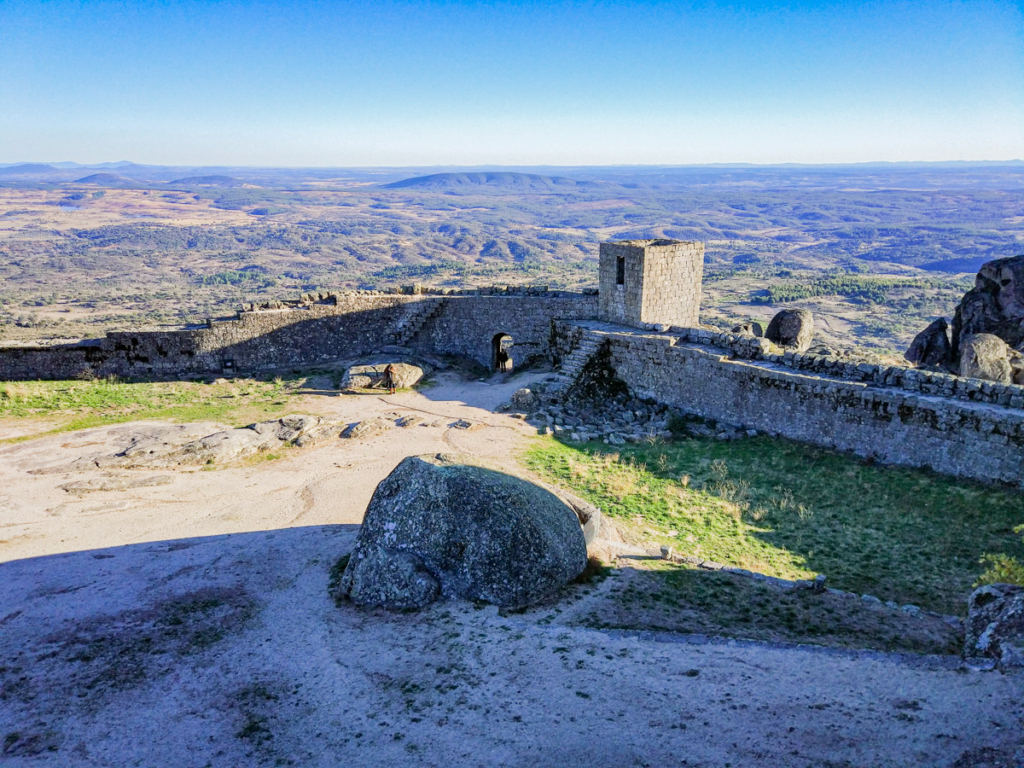
- The pigsties (known as Furdas by the locals).
- The Boulder Houses of Monsanto.
- The Chapel of the Holy Spirit, which dates back to the 17th century and has a small bell tower. It was part of the village wall, which arose after the 7 Years’ War, and surrounded the town, linking it to the castle.
- The Manueline-style Chapel of Santo António.
- The so-called Penedos Juntos and Penedo do Pé Calvo (famous boulders in Monsanto).
- The various fountains in the village of Monsanto, namely the ones called: Chafariz da Fonte Nova, Chafariz do Meio, Chafariz Mono and Fonte Ferreiro.
- The Mother Church of São Salvador.
- The Tower of Lucano, a symbol of Monsanto, not forgetting the replica of the silver rooster.
- Monsanto Pillory.
- The noblest houses, such as the Solar dos Priores de Monsanto, Solar dos Pinheiros or Solar do Marquês da Graciosa.
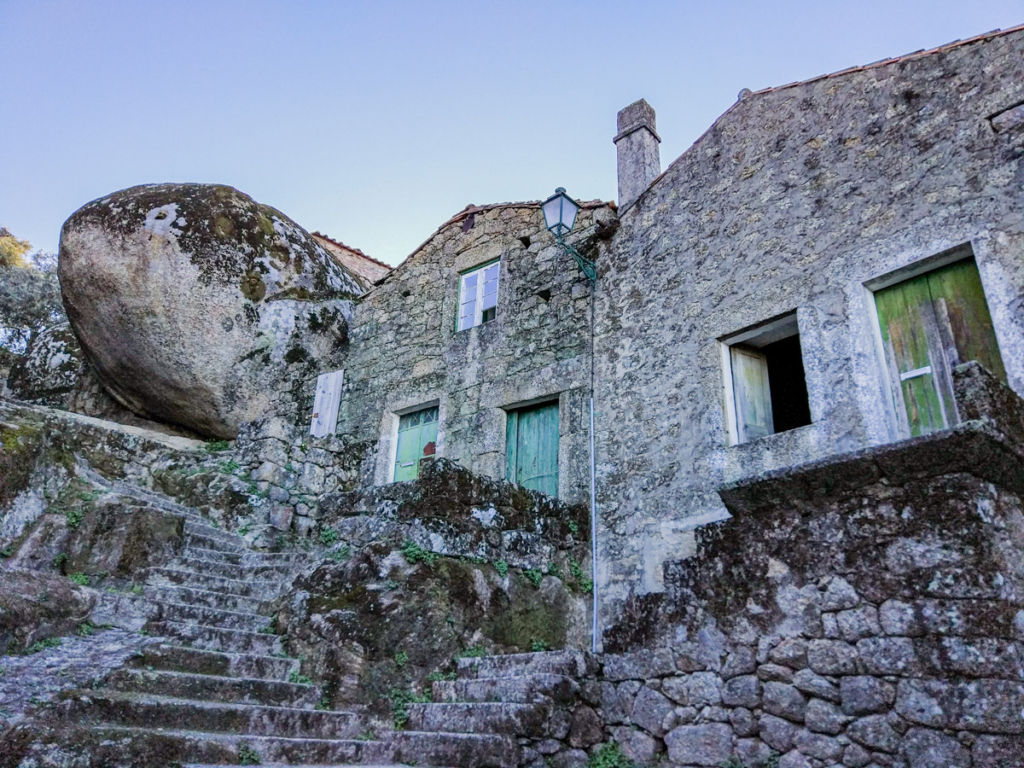
2. Surroundings of Monsanto – Penha Garcia and Thermal Baths of Monfortinho
Around the village of Monsanto, there are other historic villages in Portugal to discover. Here are some of the nearest attractions you can’t miss when visiting Monsanto and the surrounding region:
- Visit Penha Garcia Castle, whose origins are in doubt. Some say it was built by the Templars on top of an ancient Roman fortification, but others claim that it was built by King Sancho I and then donated to the Order of Santiago, and only later to the Templars by King Dinis.
- Visit the Mother Church of Penha Garcia. It dates back to the 13th century and the image inside of Senhora do Leite, dating from the 15th century, stands out.
- Enjoy the view of the Penha Garcia Reservoir.
- Relax at Pego River Beach.
- Discover the watermills of Penha Garcia.
- Take the Fossils Route, the most unmissable activity to do in Penha Garcia, which, as well as taking you to the points already mentioned, will lead you to find the fossils of the Penha Garcia Ichnological Park, one of the main geosites of the Naturtejo Geopark recognized by UNESCO. The fossils are located on the cliffs of the Ponsul River valley and date back some 480 million years.
- Spend a few days recovering your batteries at the Thermal Baths of Monfortinho.
Penamacor | Extra on the Route of Portugal’s Historic Villages
At the end of your tour of Portugal’s historic villages, you can also choose to visit Penamacor. As well as its castle, don’t forget the pillory and surrounding area, the municipal museum, the Republic Garden, the Church of Misericórdia, the Church of S. Tiago, and the Penamacor Town Hall.
In the surrounding area you can go to the Meimoa Dam to take a dip in its river beach.
I hope you enjoy this tour of Portugal’s historic villages as much as I did! Tell me all about your experience in the comments. Have a good trip in my country!
Other Itineraries and Travel Guides in Portugal
- N2 Portugal Road Trip Itinerary
- Madeira Itinerary and Travel Guide
- São Miguel Itinerary and Travel Guide (Azores)
- Terceira Itinerary and Travel Guide (Azores)
- Pico Itinerary in Azores
- Faial Itinerary in Azores
- Minho | Northern Portugal Itinerary
- Porto Itinerary and Travel Guide
- Things to do In Braga (Minho)
- Things to do in Guimarães (Minho)
- Things to do in Viana do Castelo (Minho)
- Peneda Gerês National Park Itinerary
- Douro Valley Itinerary
- Trás-os-Montes Itinerary
- Things to do in Bragança
- Montesinho Natural Park Itinerary
- Douro International Natural Park Itinerary
- Things to do in Aveiro
- Things to do in Coimbra
- Things to do in Leiria
- Things to do in Fatima
- Things to do in Nazaré
- Things to do in Peniche
- Things to do in Évora (Alentejo)
- Things to do in Beja (Alentejo)
- Algarve Road Trip Itinerary
- Things to do in Lagos (Algarve)
- Things to do in Portimão (Algarve)
- Things to do in Faro (Algarve)
- Things to do in Tavira (Algarve)
